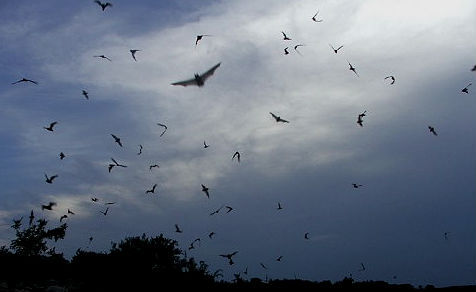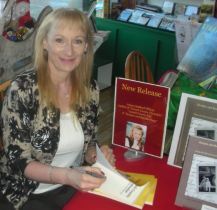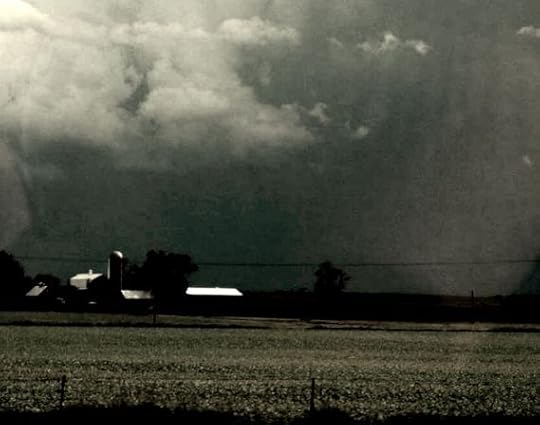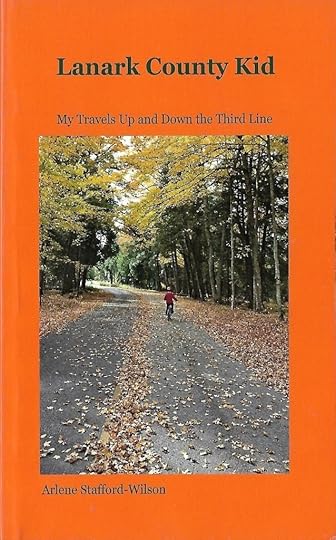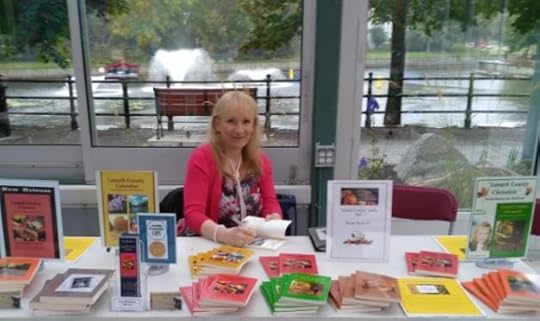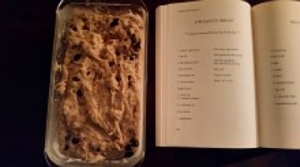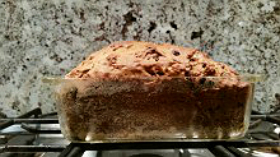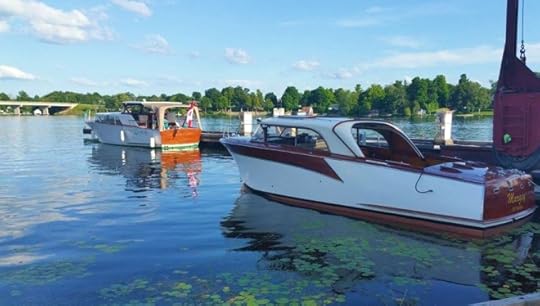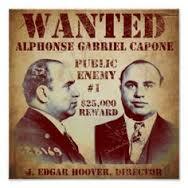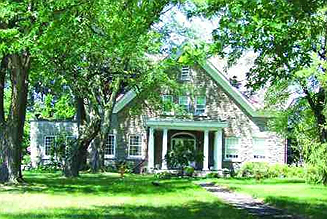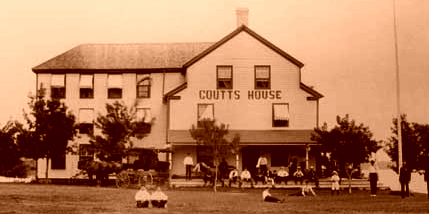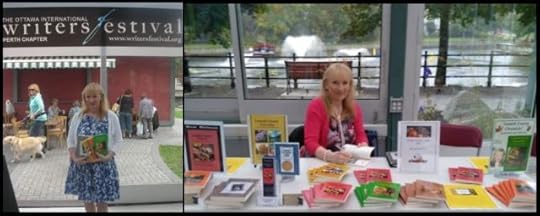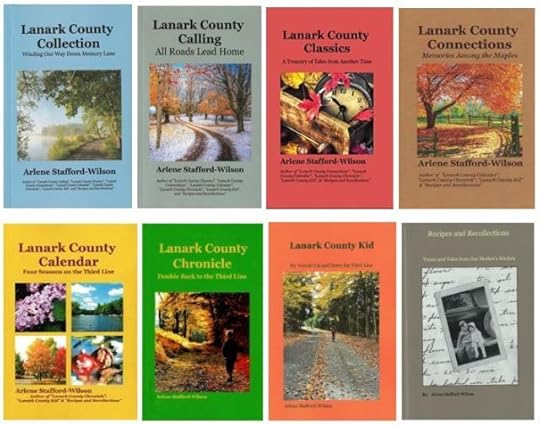Arlene Stafford-Wilson's Blog, page 30
July 28, 2022
Norvic Lodge, Christie Lake

Norvic Lodge
Victor Lemieux and his wife Noreen (McGlade) Lemieux were owners and operators of Norivc Lodge. Like the other properties set along the shores of Christie Lake, they had a beautiful shoreline, framing their homey, rustic lodge.
Victor, son of Jeremie Lemieux, and Margaret Hannah James, was born and raised in the tiny village of Fournier, in the township of Prescott-Russell. The village is situated near the communities of Vankleek Hill, St. Isidore, and Plantagenet, a largely French-Canadian settlement. Victor’s father was a Lumberman, and his mother cared for the large family.
Victor’s wife, Noreen, grew up in the town of Perth, Ontario, the daughter of Arthur McGlade. The McGlade family were early settlers from Perth, originally from County Armagh, Ireland. Catherine McCarthy McGlade, Noreen’s mother, was also from an Irish pioneer family, from County Cork. Noreen’s parents were married in Toledo, Ontario, October 16, 1899.
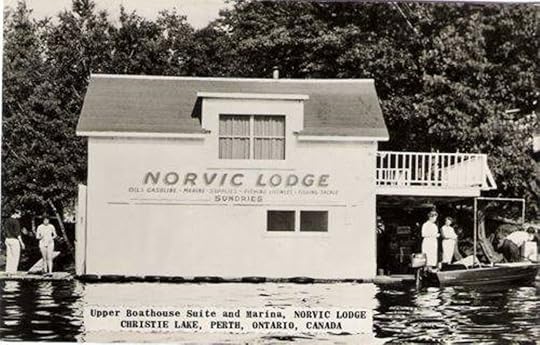
Norvic Lodge Boathouse, 1956
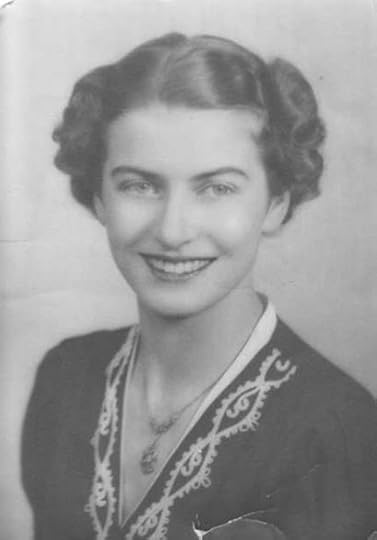
Noreen ‘Neen’ ‘Neena’ McGlade Lemiuex, Co-Owner, Norvic Lodge
Dining Room
at Norvic Lodge

Dining Room, Norvic Lodge, overlooking Christie Lake – c 1960
Working at
Norvic Lodge
Memories of working at Norvic Lodge in 1960, as told by Judy (Stafford) Ryan:
“The Lodge was ‘Norvic” named after the owners – Noreen and Vic. She was called Neena, ‘Neen’, and they had a daughter Judy, – about my age at the time. The Lodge was on Christie Lake.
I was the only one in our family who had the job there, but because I also had a two week job at the Optometrist in Perth, while his secretary was on vacation, at the beginning of the Summer (Dad got it for me), my sister Jackie (Stafford) Wharton, went up to the Lodge, and held my job for me for that two week period. I think Dad was also the one who got me the job at the Lodge. Mother did not want me to go as she figured I would get ‘into trouble’.
We were paid $10.00 a week which was given to us at the end of the Summer. We made great tips from the Americans, who stayed in the cabins – I could make up to $100.00 a week, depending on whether or not the cabins were full that week.
Our cabin was at the top of a hill away from the vacationers. Our day started at 7:00 a.m. We had to be down the hill to the Lodge in uniform, to set up the dining room for breakfast, take breakfast orders, serve it, clear tables and help wash dishes, etc. We then went back up the hill, changed into shorts and t-shirts and cleaned all the cabins – made beds, dusted, vacuumed, cleaned bathrooms, changed towels, etc. Then, back up the hill, back into uniform, to do the lunch thing.
We were supposed to have a couple of hours off each afternoon, to do what we wanted. However, part way through the summer, the lady who did the laundry left, and that was added to our jobs, without extra pay. So after lunch, we would have to do the laundry – sheets, towels, etc. and hang them out on a line to dry. Once a week, we would have to strip the beds, but changed the towels often.
On days when we didn’t have to do the laundry, I would take the canoe, and a good book, and head for a small uninhabited island, and read for a couple of hours. I knew that no-one could get to me there.
Between 4:00 and 5:00 p.m. we were back down the hill, in our uniforms, to set up for dinner, etc., etc.
After everything was done, and cleaned up for the evening, we had time to ourselves, if we had any energy left. I worked with a girl by the name of Claudette, and she was a real party girl, and as there was a party at some cottage every night, we went out most nights, along with the guy who worked at the Lodge store and gas bar, and he was allowed to use one of the motor boats, and that is how we got to the other cottages.
Just before I arrived to work at the Lodge that Summer there had been a bad boating accident, and I think one or two people had died. The only way I found out about it was I saw a mangled boat with blood on it, stored in behind the lodge, when I was out walking one day, and asked the guy at the gas bar what happened.
That Summer was the first time I saw death! There was a delightful family from Pennsylvania. there – three generations – Grandfather, parents, and two younger children. I was serving breakfast this one morning, and the Grandfather, who was always so friendly and animated, told me about the different birds he had heard singing that morning, and during the conversation, he keeled over at the table. I ran into the kitchen and got Vic (Lemieux) – told him the old man ‘fainted’. Vic got the son to help him carry the Grandfather into the Lounge, behind the dining room, and they put him on the couch. I remember going ahead and serving the other guests, and noticed people coming and going to the Lounge. Nina told me later that the old guy had died, probably instantly, and I was really shocked and upset. That is one of those memories that is permanently etched in your memory, especially when you are only 15.”

Norvic Lodge ad – 1971

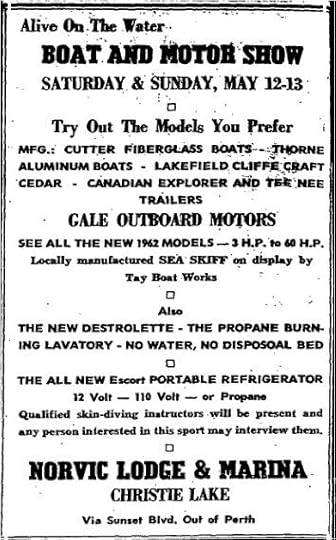
Ad – 1962
Waterskiing
at Norvic Lodge
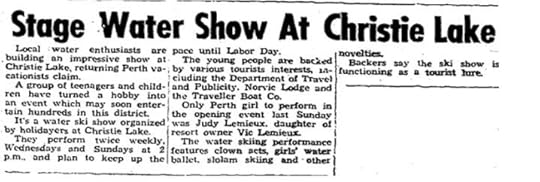
Waterskiing Show 1963
Christie Lake Surfers
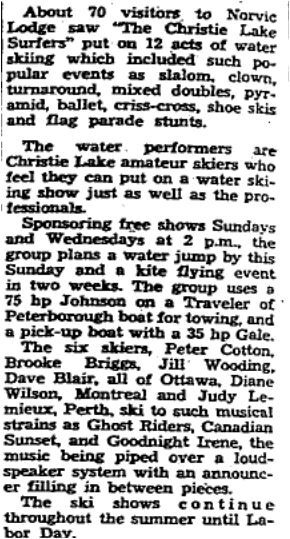

What became of Norvic Lodge?
Norvic Lodge closed many years ago, and so we are left with our memories of this special place – the home-cooked meals, Vic, Neena, the peaceful lake, the great fishing, and the excitement of the water-skiing shows will stay with us always.

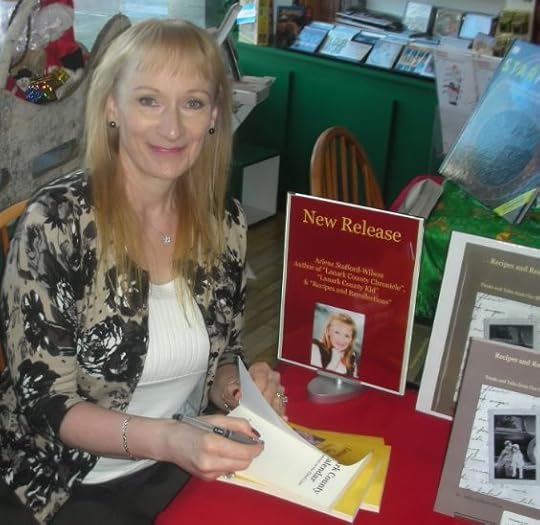
Arlene Stafford-Wilson
July 27, 2022
Bustling With Bats – Summer Nights in the Country
As the fiery red July sun sank low on the horizon, finally disappearing behind Mitchell’s barn, the first bats of the summer evening swooped low, along the maple trees in our yard. Their small, dark, shadowy figures glided effortlessly, along the lowest branches, and dotted the skies over the clothesline, at the side of the old house.

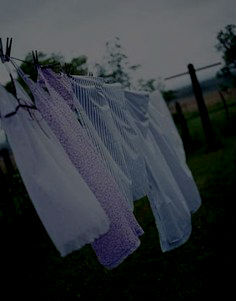
The little brown bats returned to our yard every spring, and the mothers produced just one baby each year, around the middle of June. By the end of July, the babies took their first flights, as they were weaned off of their mother, and began to eat insects.
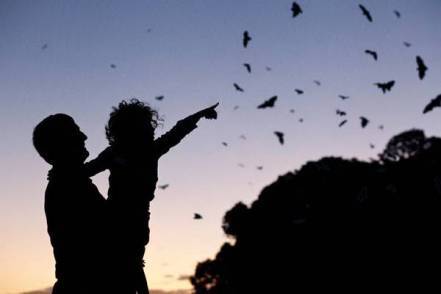
Although some people were afraid that the bats would fly into their hair, they made a high frequency sound that bounced back, and prevented them from colliding with anything – other than the mosquitoes they feasted on nightly.
Because they were nocturnal creatures, we never saw them in the daytime, as they hung upside down, under the eaves of the roof, or sought shelter in the attic, above the kitchen. Around sunset each summer evening, they begin to soar around the yard, swooping and gliding, along the branches, seeking out the bloated mosquitoes that dined on us, as we sat outside in the evening.

Mother and Dad didn’t mind sharing our yard with the bats. Our parents sat on their lawn chairs, enjoying a plate of homemade oatmeal cookies; Dad with a coffee in hand, and Mother with her lemonade.

The summer days were hot, often humid, and the only form of air conditioning in the old house was to open a window, and hope for the best. Sitting outside under the big maple trees in the evening was a nice way to cool down, and reflect on the events of the day. We’d glance down the lane, watch the cars going by on the Third Line, and one at a time, turn on their headlights for the night.
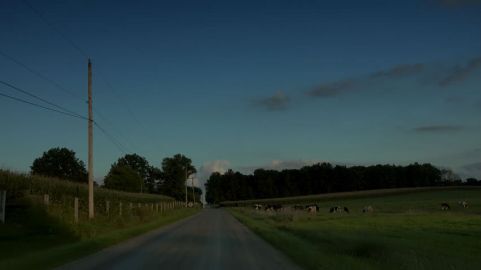
The crickets and bullfrogs were in full chorus by then, as more and more bats appeared, and the sky became a dark cloak, shrouding their movements in secrecy. Small flashes of light moved along the front garden, as the fireflies began their nightly parade, competing with the bats for our attention.

As the summer season unfolded, there would be many nights like this. We’d sit outside to cool down, after a long hot day, and we became the audience for the sunset performance of the small brown bats, and their aerial show.
Mother and Dad would eventually rise from their lawn chairs, and fold them up for the evening; carrying their empty cups, and the scattered crumbs remaining on the cookie plate.

The bats would continue their hunt for food long after we’d gone into the old house, gliding and darting in the yard, as we slumbered peacefully through the warm summer night.

………………….
(an excerpt from ‘Lanark County Calendar: Four Seasons on the Third Line, ISBN 978-0-9877026-30)
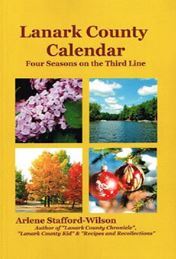
Arlene Stafford-Wilson
July 26, 2022
Innisville Scribe -Elsie Kilfoyle

Some called her ‘Ma’, the kids who bought candy at her general store called her Mrs. Kilfoyle, and everyone in Innisville knew that Elsie was the official village scribe. For many decades she kept careful notes on all of the local activities, the weather events, the fishing conditions, who was visiting, anniversaries, marriages, births, and deaths.
Elsie (McLaren) Kilfoyle was a regular columnist for a total of 4 newspapers, three of them for over 40 years spanning from 1936 until 1976, the year of her death.
On July 26, 1962, one of the newspapers, “The Perth Courier”, published an article on Elsie, transcribed below:
“Twenty-five years have not dulled Mrs. W.P. Kilfoyle’s enthusiasm as the Courier’s Innisville correspondent.
As she says herself, “I enjoy it very much. If I didn’t enjoy it then I would quit.”
Although Mrs. Kilfoyle, now 67 years old, cannot remember the exact date she began to write for the Courier, she estimates that she has been on the job since 1935 or 1936.
At the turn of the century the Kilfoyle’s purchased the Innisville General Store which they have operated for 63 years. Mrs. Kilfoyle, whose husband died two years ago, has four sons, Stan 41, Jerry 39, Wallace 37, and Murray, 35.
Long History
Mrs. Kilfoyle is Innisville’s true hometown girl, having been born there in 1881. She has resided there all her life except for a span of 15 years when she “went away to Franktown to live after her marriage in 1919.” In 1933, however, she and her husband returned to own and operate the Innisville General Store which she had inherited after the death of her mother.

In the Village
The Kilfoyle’s have a long history in Innisville dating back to that area’s first settler John Morris, Mrs. Kilfoyle’s great great grandfather. He is reported to have lived under the protection of a large overhanging rock for many months until he completed a flimsy shack near the river.
Mrs. Kilfoyle’s parents, (James McLaren and Elizabeth Morris), now deceased, lived on a farm about one mile from Innisville which they homesteaded in the early 1880s.
Strange Stories
Having been a lifetime resident of Innisville she remembers some unusual occurrences in that village.
Over 50 years ago, she reports, when a great many suckers inhabited the Mississippi, every spring a man built a big 4-ft. high stone pond in the river. In this enclosure he used to trap as many as 1,000 suckers a day. People came with wagons, bought the fish by the bagfuls and took them away to be salted.
Twelve years ago, Mrs. Kilfoyle was involved in a rather strange event. “Mr. Wm. Cavanagh from Pakenham, had just parked his truck in front of the store. He came in and asked to buy something, so I went to the kitchen to get it. As I looked through the kitchen window I saw a truck rolling toward the river. I told Mr. Cavanagh and we rushed outside. It was his truck and the brake had apparently failed. Fortunately the truck struck a rock pile on the river bank or it would have rolled into the Mississippi which was at that time much higher and swifter than it is today.
The old bridge through the village, when a part of the main highway, brought many visitors to Innisville and many customers to our store, says Mrs. Kilfoyle. “Although the new bridge is not the traffic hazard of the old one, since it went in too many people don’t know Innisville even exists.”
Digs for News
She estimates the population of the village is about 80 persons, although in the summer many more people live in the immediate area. It is easy to see the difficult task Mrs. Kilfoyle has in digging up news every week with so few people in the area.
“There are some weeks that I think, ‘Why should I write?’ “, says Mrs. Kilfoyle. “But then I think of the people in other places such as British Columbia, who have interests here. When they receive the Courier the first thing they do is look for the Innisville news. When I think of this I try to think something up.”
The method by which Mrs. Kilfoyle gathers news for the Courier has remained the same for the past 25 years. “I just listen to somebody talking and I jot it down so I won’t forget. A few people also bring in some information each week.”
Although Mrs. Kilfoyle admits that being on a party line should add to her quantity of news, she refrains from listening to conversation because of the embarrassing situation that would arise if a customer walked into the store while she was listening on the telephone.
“Sometimes I wish I didn’t have the store”, she says.
As a sideline to her activities as a store owner and a correspondent for three weekly newspapers, Mrs. Kilfoyle raises flowers in her “spare time”.
She has over 75 house plants decorating her windows, the most beautiful of which is an African Violet given to her ten years ago. It has bloomed consistently each year and as many visitors to the Kilfoyle home have commented, “grows a bigger leaf and more beautiful flower each year.”
So enthused is Mrs. Kilfoyle about her hobby that she states that she would go into the greenhouse business if she were 40 years younger.
The Courier congratulates Mrs. Kilfoyle on her 25 years as one of their most able correspondents.
(transcribed from “The Perth Courier” article titled, “25 Years as a Courier Correspondent”, published July 26, 1962)
Old Innisville Bridge

Old Bridge, Innisville – photo: Perth Remembered

Old Innisville Bridge, built 1820s – ladies below, doing their laundry, photo: Middleville Museum
W.P. Kilfoyle, Elsie’s husband
Elsie’s husband – Willard Preston Kilfoyle (1888-1958), photo: when he worked as a Cheese Maker

Willard Preston Kilfoyle
Marriage Certificate – Elsie’s marriage to Willard in May 1919, in Carleton Place
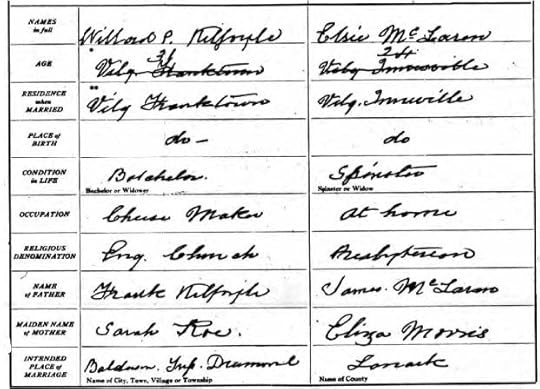
Married in Carleton Place, Ontario, May 7, 1919
Elsie and Willard had four sons:
Stanley (1920-2007) (married Ernestine M. Rathwell)
Gerald (1921-1968) (married Mary Catherine ‘Casey’ Stafford)
Wallace (1924-2019) (married Audrey Ida Cooke)
Murray (1926-1987) (married Verna Sutherland)
Innisville Anglican Church

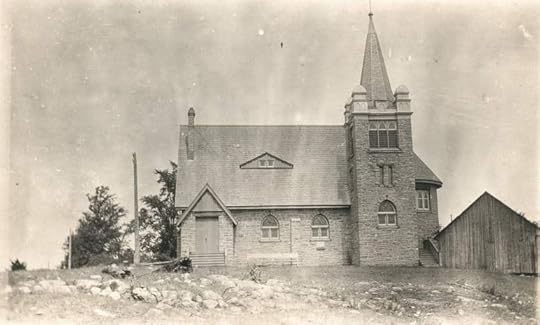
Innisville School –
S.S. # 17, Drummond Township
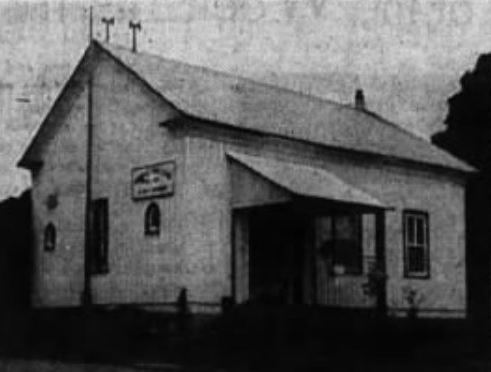
Innisville School -1888

1936-1937
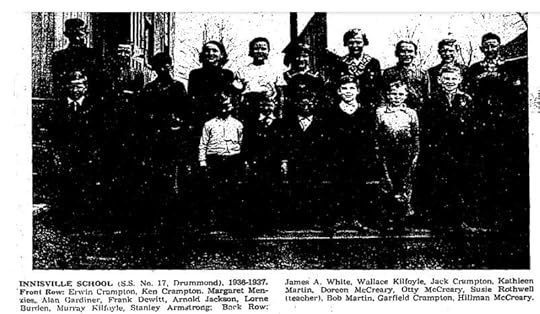
Elsie Kilfoyle passed away in Carleton Place, on March 16, 1976 at the age of 81.
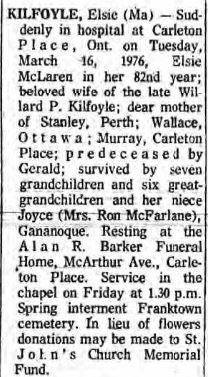
March 17, 1976, “The Ottawa Journal”
“The welcome mat was always at her door and she was widely known for having kept the store in Innisville for years, and had cottages and boats which attracted many American tourists.”
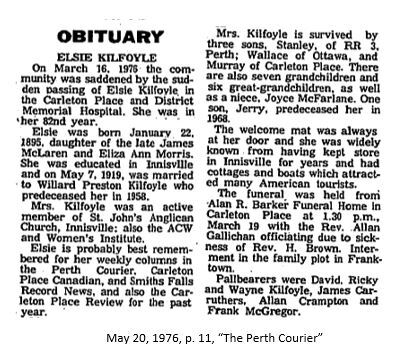
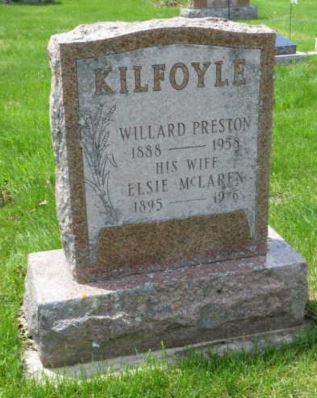
Elsie and Willard Kilfoyle, Franktown Cemetery
The End of an Era
And so…….Elsie Kilfoyle, social columnist, gathered, assembled, and reported the Innisville news for over 40 years, recording every event, every gathering, every visit, special trips and vacations taken by residents, births, engagements, marriages, deaths, and funerals. She knew that there might be someone out there, someone maybe as far as British Columbia, as she told the reporter in 1962, someone who might be waiting patiently for their weekly copy of one of her papers, like “The Perth Courier”, who would turn first to the news of Innisville. It might be someone who grew up there, a former member of their local Anglican church, or someone who went to the old S.S. # 17 school. For four decades Elsie made sure that her readers would not be disappointed when they looked in their papers for the goings-on in the area. After all, her column might even be the highlight of that reader’s week – a little dash of current events, some snippets from that pretty little village along the mighty Mississippi, some tidbits from across the miles, some precious news connecting the reader back home, to Innisville.
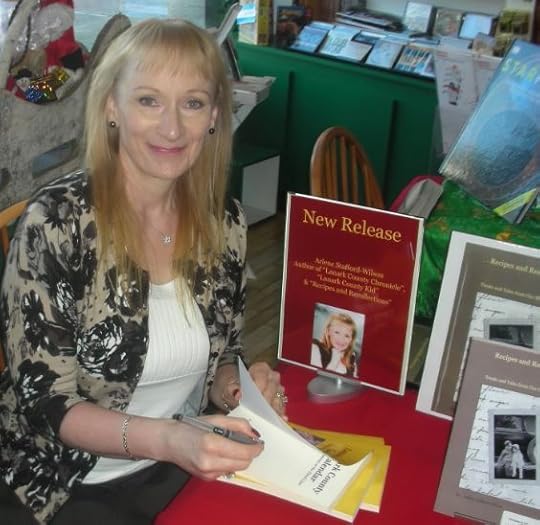
Arlene Stafford-Wilson
(In 1946, Ivan Gerald ‘Gerry’ Kilfoyle, Elsie’s son, married my father’s older sister, Mary Catherine ‘Casey’ Stafford)
Elsie Kilfoyle – Innisville Scribe

Some called her ‘Ma’, the kids who bought candy at her general store called her Mrs. Kilfoyle, and everyone in Innisville knew that Elsie was the official village scribe. For many decades she kept careful notes on all of the local activities, the weather events, the fishing conditions, who was visiting, anniversaries, marriages, births, and deaths.
Elsie (McLaren) Kilfoyle was a regular columnist for a total of 4 newspapers, three of them for over 40 years spanning from 1936 until 1976, the year of her death.
On July 26, 1962, one of the newspapers, “The Perth Courier”, published an article on Elsie, transcribed below:
“Twenty-five years have not dulled Mrs. W.P. Kilfoyle’s enthusiasm as the Courier’s Innisville correspondent.
As she says herself, “I enjoy it very much. If I didn’t enjoy it then I would quit.”
Although Mrs. Kilfoyle, now 67 years old, cannot remember the exact date she began to write for the Courier, she estimates that she has been on the job since 1935 or 1936.
At the turn of the century the Kilfoyle’s purchased the Innisville General Store which they have operated for 63 years. Mrs. Kilfoyle, whose husband died two years ago, has four sons, Stan 41, Jerry 39, Wallace 37, and Murray, 35.
Long History
Mrs. Kilfoyle is Innisville’s true hometown girl, having been born there in 1881. She has resided there all her life except for a span of 15 years when she “went away to Franktown to live after her marriage in 1919.” In 1933, however, she and her husband returned to own and operate the Innisville General Store which she had inherited after the death of her mother.

In the Village
The Kilfoyle’s have a long history in Innisville dating back to that area’s first settler John Morris, Mrs. Kilfoyle’s great great grandfather. He is reported to have lived under the protection of a large overhanging rock for many months until he completed a flimsy shack near the river.
Mrs. Kilfoyle’s parents, (James McLaren and Elizabeth Morris), now deceased, lived on a farm about one mile from Innisville which they homesteaded in the early 1880s.
Strange Stories
Having been a lifetime resident of Innisville she remembers some unusual occurrences in that village.
Over 50 years ago, she reports, when a great many suckers inhabited the Mississippi, every spring a man built a big 4-ft. high stone pond in the river. In this enclosure he used to trap as many as 1,000 suckers a day. People came with wagons, bought the fish by the bagfuls and took them away to be salted.
Twelve years ago, Mrs. Kilfoyle was involved in a rather strange event. “Mr. Wm. Cavanagh from Pakenham, had just parked his truck in front of the store. He came in and asked to buy something, so I went to the kitchen to get it. As I looked through the kitchen window I saw a truck rolling toward the river. I told Mr. Cavanagh and we rushed outside. It was his truck and the brake had apparently failed. Fortunately the truck struck a rock pile on the river bank or it would have rolled into the Mississippi which was at that time much higher and swifter than it is today.
The old bridge through the village, when a part of the main highway, brought many visitors to Innisville and many customers to our store, says Mrs. Kilfoyle. “Although the new bridge is not the traffic hazard of the old one, since it went in too many people don’t know Innisville even exists.”
Digs for News
She estimates the population of the village is about 80 persons, although in the summer many more people live in the immediate area. It is easy to see the difficult task Mrs. Kilfoyle has in digging up news every week with so few people in the area.
“There are some weeks that I think, ‘Why should I write?’ “, says Mrs. Kilfoyle. “But then I think of the people in other places such as British Columbia, who have interests here. When they receive the Courier the first thing they do is look for the Innisville news. When I think of this I try to think something up.”
The method by which Mrs. Kilfoyle gathers news for the Courier has remained the same for the past 25 years. “I just listen to somebody talking and I jot it down so I won’t forget. A few people also bring in some information each week.”
Although Mrs. Kilfoyle admits that being on a party line should add to her quantity of news, she refrains from listening to conversation because of the embarrassing situation that would arise if a customer walked into the store while she was listening on the telephone.
“Sometimes I wish I didn’t have the store”, she says.
As a sideline to her activities as a store owner and a correspondent for three weekly newspapers, Mrs. Kilfoyle raises flowers in her “spare time”.
She has over 75 house plants decorating her windows, the most beautiful of which is an African Violet given to her ten years ago. It has bloomed consistently each year and as many visitors to the Kilfoyle home have commented, “grows a bigger leaf and more beautiful flower each year.”
So enthused is Mrs. Kilfoyle about her hobby that she states that she would go into the greenhouse business if she were 40 years younger.
The Courier congratulates Mrs. Kilfoyle on her 25 years as one of their most able correspondents.
(transcribed from “The Perth Courier” article titled, “25 Years as a Courier Correspondent”, published July 26, 1962)
Old Innisville Bridge

Old Bridge, Innisville – photo: Perth Remembered

Old Innisville Bridge, built 1820s – ladies below, doing their laundry, photo: Middleville Museum
W.P. Kilfoyle, Elsie’s husband
Elsie’s husband – Willard Preston Kilfoyle (1888-1958), photo: when he worked as a Cheese Maker

Willard Preston Kilfoyle
Marriage Certificate – Elsie’s marriage to Willard in May 1919, in Carleton Place

Married in Carleton Place, Ontario, May 7, 1919
Elsie and Willard had four sons:
Stanley (1920-2007) (married Ernestine M. Rathwell)
Gerald (1921-1968) (married Mary Catherine ‘Casey’ Stafford)
Wallace (1924-2019) (married Audrey Ida Cooke)
Murray (1926-1987) (married Verna Sutherland)
Innisville Anglican Church


Innisville School –
S.S. # 17, Drummond Township

Innisville School -1888

1936-1937

Elsie Kilfoyle passed away in Carleton Place, on March 16, 1976 at the age of 81.

March 17, 1976, “The Ottawa Journal”
“The welcome mat was always at her door and she was widely known for having kept the store in Innisville for years, and had cottages and boats which attracted many American tourists.”


Elsie and Willard Kilfoyle, Franktown Cemetery
The End of an Era
And so…….Elsie Kilfoyle, social columnist, gathered, assembled, and reported the Innisville news for over 40 years, recording every event, every gathering, every visit, special trips and vacations taken by residents, births, engagements, marriages, deaths, and funerals. She knew that there might be someone out there, someone maybe as far as British Columbia, as she told the reporter in 1962, someone who might be waiting patiently for their weekly copy of one of her papers, like “The Perth Courier”, who would turn first to the news of Innisville. It might be someone who grew up there, a former member of their local Anglican church, or someone who went to the old S.S. # 17 school. For four decades Elsie made sure that her readers would not be disappointed when they looked in their papers for the goings-on in the area. After all, her column might even be the highlight of that reader’s week – a little dash of current events, some snippets from that pretty little village along the mighty Mississippi, some tidbits from across the miles, some precious news connecting the reader back home, to Innisville.

Arlene Stafford-Wilson
(In 1946, Ivan Gerald ‘Gerry’ Kilfoyle, Elsie’s son, married my father’s older sister, Mary Catherine ‘Casey’ Stafford)
July 25, 2022
July Thunders Through Our Yard
“Louder and louder the deep thunder rolled,
as through the myriad halls of some vast temple in the sky;
fiercer and brighter came the lightning;
more and more heavily the rain poured down.”
Charles Dickens
Thunderstorms in the country followed days of still air that was heavy, and thick with humidity. The leaves on the poplar trees outside my bedroom window fluttered, and eventually turned their backs toward us, as though they were bracing for what was to come. The birds scurried back to their nests to take shelter, and the squirrels and chipmunks sped quickly toward their homes without looking back.
The sky changed from a playful, summer blue as the heavy, dark, grey clouds rolled in over the old house. The largest, darkest clouds appeared menacing and powerful as they hung low over the yard, turning midday into night.
I could see the first streak of lightning as it lit up the sky around Mitchell’s barn. Seconds later, the thunder crash was so loud that I instinctively ran downstairs, hoping to find some comfort in the grownups who had gathered in the living room.
“There’s nothing to be afraid of.”, Mother would say, matter-of-factly, as Great Aunt Clara sprinkled holy water over the lamps and the around the doorways. “Let’s play a game and count the seconds after the lightning flashes to see how close the thunder follows.” Mother said. I wasn’t in much of a state to play a game and wondered if this was her way to take my mind off of the dangers of the storm.
The rain was coming down in sheets, and the wind was pounding it against the kitchen windows so hard that I thought that any minute the glass would break. Another bolt of lightning lit up the house, followed by an ominous crash, and I wondered if it had hit one of the big maple trees outside. Great Aunt Clara scurried into the living room without glancing my way, as though she knew that I’d see the sheer terror in her eyes.
This went on for several minutes, that seemed like hours, until the flashes became less frequent and the thunder moved off into the distance, and the whole house and all of its occupants seemed to breathe a collective sigh of relief.
I went back upstairs and watched from the window until the dark clouds moved along in the sky, back toward the railroad tracks. It was as though someone had turned the lights back on and patches of blue dotted the sky again and the sun burst out from behind the big grey mass overhead.
There would be many storms in the heat of July, and they all began and ended the same. It would commence with menacing skies, deafening thunderclaps and a shared fear of the unknown. It would end with calm skies, nervous laughter and gratitude for the abundance of rain that had quenched the thirsty farmlands around us.
…………………….
Excerpt from “Lanark County Calendar: Four Seasons on the Third Line”

Arlene Stafford-Wilson
July 22, 2022
Rideau Ferry Inn – Those Hot Summer Nights!

Oh, those hot summer nights at the Rideau Ferry Inn! The dancing, the laughter, stolen kisses, sneaking drinks in the parking lot, and the best live rock and roll around!
Its official name back then, was the Poonamalie Pavilion, but nobody called it that. To my friends and me, it was simply the Rideau Ferry Inn; and you could find us there most weekend nights in the summer, socializing, laughing, and dancing the night away.
Situated along the clear, blue waters of the Rideau, the Rideau Ferry Inn has hosted many generations of tourists and boaters, providing sumptuous meals, comfortable accommodation, and lively entertainment. Arguably, the highlight of the small settlement of Rideau Ferry, our former teenage haunt, wasn’t the original structure at this location. The original building was actually a home.
The original structure was a house built in 1853 by Archibald Campbell. Archibald married Elizabeth Buchanan, a preacher’s daughter. Her father was the Reverend George Buchanan, and was one of the early Presbyterian ministers of Beckwith Township, serving the congregation at Franktown.
Their daughter, Helen Buchanan Campbell, married John Coutts. As her parents were aging, and needed assistance, the couple moved in with them in 1870. During that time, John made some additions to the home, and when he was finished, they not only had ample room for themselves, but had more than enough room to accommodate guests. They began to rent rooms in the house to summer tourists, who were traveling by boat ,along the mighty Rideau waterways.

As the years went by, their home became known as ‘Coutts House’, and eventually, had the reputation of being a very fine hotel. In 1893 a three-storey addition was built at the back of the house. A large dining room was added to the first floor. The second and third floors had fifteen hotel rooms each, and an indoor bathroom.
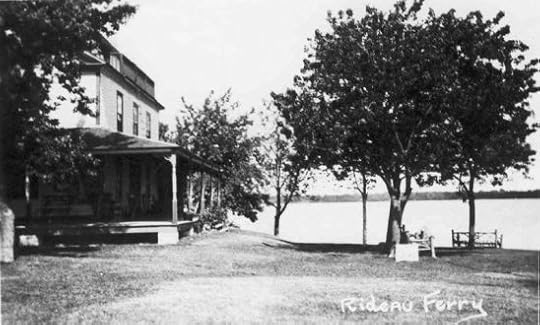
After 1905, the building was rented to a series of business men. During the 1920s and 30s, regattas became popular, and Coutts House held canoe races, and rowboats races. The Coutts family also sponsored competitions for sailboats, and it was the site of many grand daytime celebrations, and intimate evening affairs, for the wealthy travelers, visiting in the summer.
In 1947, Doug Wallace, native of Osgoode bought Coutts House, tore it down, and built a new structure with wood framing, and grey granite blocks. It was a two-storey building, and the second floor featured a large dance area, with seating on three sides.
By the 1960s, the building had become known as the Rideau Ferry Inn, and during this time, became licensed for liquor sales. Up until that time people would smuggle in their own booze, particularly in the roaring twenties when rum-running along the Rideau had its hey-day.

It was in the 1970s, that I first heard the tales about the popular night spot, and all the good times that were had at the Rideau Ferry Inn. There were stories told up and down the halls of the Perth High School – stories of summer romances with cottagers staying at seasonal properties nearby, or the ultra-cool teens that traveled by boat along the Rideau, with their parents. There was also talk of the teenage kids from the States, and their hip clothing and accessories; styles that would take years to reach our little communities near Perth. There were lots of accounts at our high school of the talented rock bands that performed, and of the nights spent dancing to the top hits played by edgy disc jockeys. I couldn’t wait to go and see it for myself.
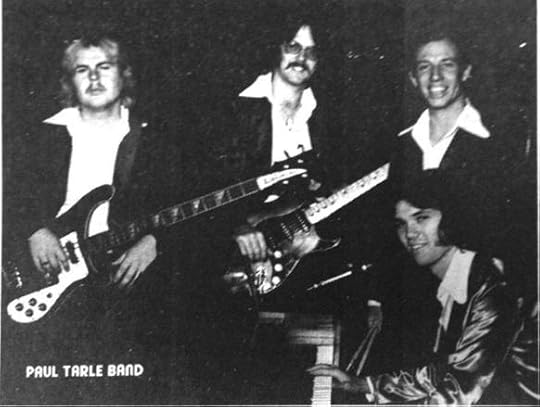
The main house-band at ‘The Inn’ in the early 1970s was the Paul Tarle Band – and we showed off our cool dance moves, as we listened to their popular rock classics.

One of the best parties of our steamy Lanark County summers was the annual Rideau Ferry Regatta. Beautiful, sleek, boats from all over, competing for the sought-after prizes, and the prestige of being ‘Number 1’ on the big lakes.
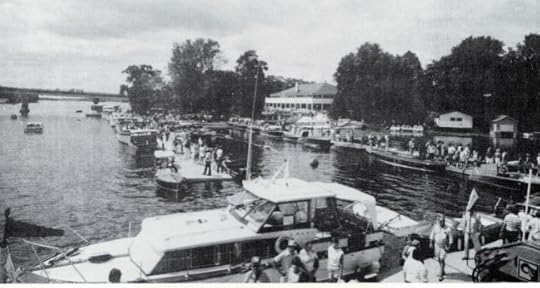
Regattas were all about hot sun, cold beers, the cool, clear waters of the Rideau Lakes, and beautiful boats all around us.

We’ll never forget the annual regattas, or the great music at the Rideau Ferry Inn. Bands like ‘Sammy Seaman’ and his group kept us up until the wee hours. Some nights it was ‘Woody Herman and the Young Thundering Herd’, and other evenings we were entertained by the ‘Paul Chabot Band’. Occasionally, instead of live bands at the ‘Inn’, there was a ‘Disco’ dance provided by a local disc jockey, by the name of ‘Sounds Great’.
Many years after our frequent teenage visits to the Rideau Ferry Inn, the building was purchased by Elmer and Eva Purdon. It was still ‘the’ place at that time to host fancy wedding receptions, or 50th wedding anniversary celebrations.
Because we’d had so many good times at the Rideau Ferry Inn, it was a terrible shock for my friends and I when we heard about the fire in February of 1986, that destroyed our former dance hall. The fire started on the top floor, where the dances had been held for so many years. The ground floor was also destroyed in the fire, and that is where the kitchen, the large dining room, and bar were located.
My friends and I drove down to Rideau Ferry a few days after the fire. I don’t think it was so much out of curiosity, but more out of disbelief. Could it be true, that the place where we’d passed so many of our happy youthful hours was really gone? There were so many memories of friendships, dancing, and all of the special evenings we spent at the Rideau Ferry Inn.
We drove up to where the Inn had stood, and looked around. No one said a word. I think that as we stared at the charred foundation of the building, each of us was recalling our own versions of the times spent there, in our youth. They were such innocent, awkward, magical, teenage times. We sat there for a few more moments, still silent, and then drove away, back up the Ferry Road toward Perth.
…
The building may be gone, but our fond memories of the Rideau Ferry Inn will remain with us forever. We will always remember the music, the friends, and the good times. Those long summer nights, when the stars seemed to shine a little brighter, the sunsets glowed a little softer. The peaceful, pristine, waters of the Rideau Lakes made a perfect backdrop for those innocent days of our youth, when life stretched out ahead of us…..so full of promise, and our dreams for the future.

………………..
An excerpt from – ‘Revelry and Rogues on the Rideau’ – ‘Lanark County Chronicle’ available in local book stores, or online. ISBN 978-0-9877026-23

……..
Local Names:
Although there were lots of tourists and visitors in the summer, they were only there for a few short weeks at most. We became acquainted with many of the folks who lived year-round at Rideau Ferry, and some of the local names at that time were: McLean, Donaldson, Buchanan, Gemmill, Frost, Sewell, Coutts, Gallagher, Beveridge, McKay, Wills, McVeety, Millar, Tully, Oliver, Dettrick, Bethune, Purdon, Hitchcock, Fitzgerald, Hall, Gould, Irving, Joynt, King, McCue, Wallace, McKay and Campbell.
…………
Join the author on a steamy hot summer night, park your car outside the Rideau Ferry Inn in the ‘passion pit’, duck as the beer-bottles fly, and the action heats up outside. Hear some of the top bands from the 1960s, 1970s, and 1980s play some classic rock and roll along the peaceful shores of the Rideau – read about it in the new book, released September 2020:
“Lanark County Collection: Winding Our Way Down Memory Lane”

available at The Book Nook, and Spark Books, in Perth, and Mill Street Books in Almonte.
Also online at http://www.staffordwilson.com
photos: Perth Historical Society, Carol-Ann McDougall, Perth Remembered, Vintage Smiths Falls and Perth, The Perth Courier, Georgia McNally, Vintage Race Boat Shop, and from private collections.For boating on the big lakes – Rideau Ferry Marina
……….
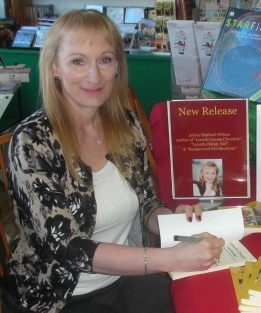
Arlene Stafford-Wilson
July 21, 2022
Herron’s Mills – Ghost Town
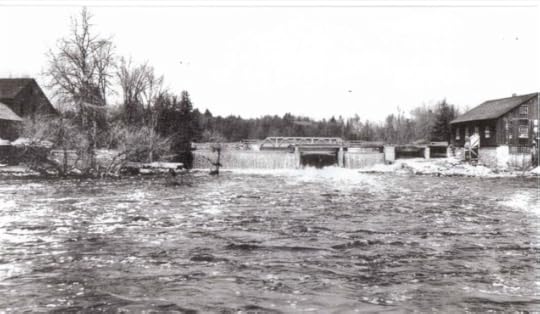
Herron’s Mills
These days, Herron’s Mills is a ghost town, but it was once a thriving community, built along the Clyde River in the Lanark Highlands, Lanark County. You can visit the area by traveling on Highway 511.
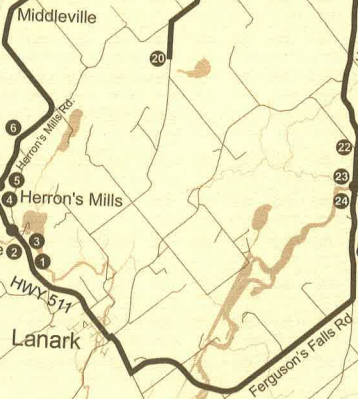 (from the Lanark Township tour)
(from the Lanark Township tour)The hamlet was originally called Gillies Mills, named for founder, John Gillies, who arrived from Greenock, Scotland in 1821, aboard the ship, ‘David of London’, with his parents, James, and Helen, and four siblings. John was an enterprising young man and by 1861 he and his wife, Mary, built a lovely home, and he established a saw mill along the banks of the Clyde River. Local legends say John Gillies traveled from Brockville, back to his home with a 90 pound saw on his back.

John Gillies, 1870

John Gillies’ house
Within a few years much of the area pine trees had been cut and Gillies was bringing in logs from other areas to his mill. He decided that it would be easier to purchase an existing mill in Carleton Place, and so he put the mill and his house up for sale.
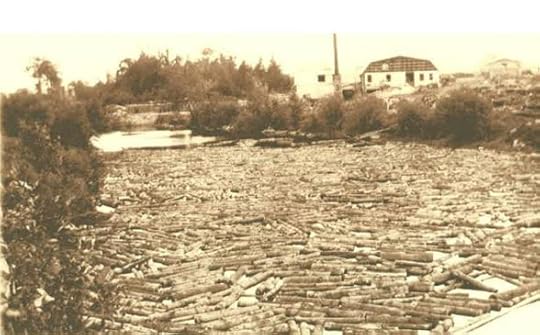
Logs in the Clyde River
Name Changed to Herron’s Mills
Gillies sold his mill in 1871 to James and John Herron who purchased the surrounding 104 acres of land as well as the mill. They re-named the mill – J & J Herron Company and the area became known as Herron’s Mills. One of the things the Herron brothers added to the operation was a stone bake-house. This was used to bake un-hulled oats or un-shelled peas. These were ground and used in oatmeal and pea ‘brose’, a popular dish at that time, brought by the settlers from Scotland.
Peas Brose, or Peas Porridge was often made in large batches and kept on the stove, as a quick and hearty meal for the mill hands coming home for lunch, or for the little ones arriving after their day at school. It was common to add a bit of water to the mixture to keep it in a paste consistency, as it would often harden from sitting on the stove top. There was a nursery rhyme at the time, its origins unknown, but thought to have become popular in the days when the pot of peas porridge was a daily sight in the settler’s kitchens:
“Pease porridge hot
Pease porridge cold
Pease porridge in the pot
Nine days old
Some like it hot
Some like it cold
Some like it in the pot
Nine days old”
Peas Porridge

Peas Brose (Peas Porridge)
Ingredients
2 ½ cups green dried split peas, soaked overnight
3 Tablespoons butter
Salt and pepper to taste
Preparation
Soak the peas for 8-12 hours in a large bowl of water
Drain and rinse the soaked peas. Then add to a saucepan of water
Cover and bring to a boil
Simmer for one hour (may be longer) until the peas are tender
Strain the peas and add the butter, salt and pepper
Serve with ham or bacon if desired (the traditional style)
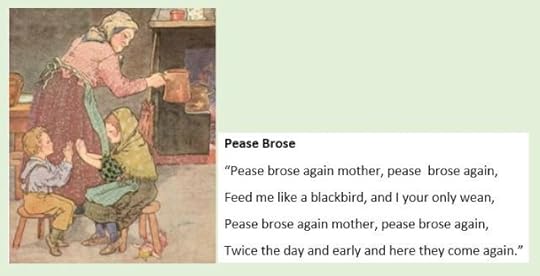
Herron’s Mills thrived, and barns and stables were built as homes for the workers. A school was constructed, and teachers were given board with local families as part of their compensation.
James Herron opened a post office in 1891, located in their home. The Herron Mills post office was in operation until 1915.
In the busiest days of the community, Herron’s Mill was producing over 8000 feet of lumber per day.
The brothers John and James Herron dissolved their partnership in 1919, and in 1920, James passed away.

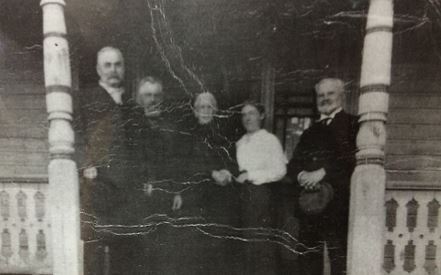
Herron Family Home, (was Gillies’ home), photo: 1915, L to R – John Ackland, James Herron,
his wife, Janet (Malloch) Herron, their daughter, Mary Herron, and Robert Ackland
After James’ death, ownership of the mill was passed down to his son, Alexander.
When Alexander passed away in 1946, his sister Mary ran the mill for five more years.
By 1951 the mill was closed, the workers moved away, and the small community of Herron’s Mills was destined to become a ghost town.
There are few signs remaining of this once thriving village, other than some abandoned structures, and the old damn which can be seen from the road.
On a Sunday drive past this pioneer community we might imagine those busy bustling days, the sounds of the mill, the children playing, and the mothers stirring their peas porridge pot on an old wood stove.
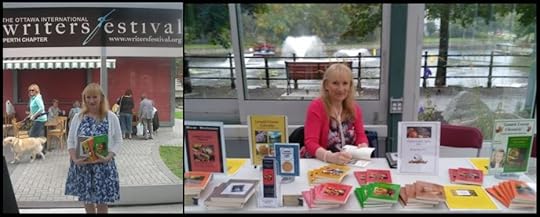
Arlene Stafford-Wilson
July 16, 2022
Ferguson Falls and the Stumble Inn
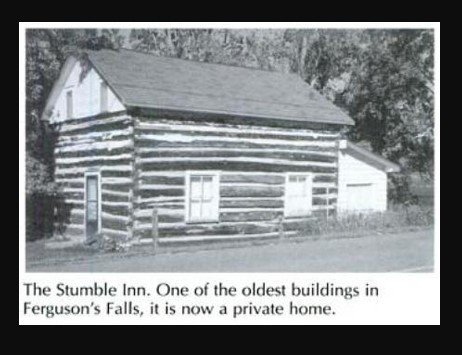 Photo: “A History of Drummond Township”, by John Ebbs, 1999, p. 21.
Photo: “A History of Drummond Township”, by John Ebbs, 1999, p. 21.Stumble Inn of Ferguson Falls
“It was a little shack very close to the old Mississippi, just across the bridge, coming down from the church; probably not room for more than twelve Irishmen at a time, if they could get along, and if that didn’t work, some would be out in yard ,or in the river.”
Thomas Joseph Stafford (1921-2018)
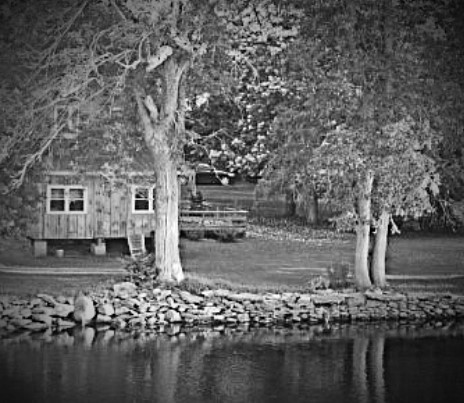 A view of the Stumble Inn from the Mississippi River
A view of the Stumble Inn from the Mississippi River“The Stumble Inn was operated by Billy McCaffrey. He was a very, very, short man, with a curved back. His bar was located right beside the river, when you crossed the old bridge, across the Mississippi River, coming down from the Catholic church. I remember it around 1927 to early 1930s. The horses were stabled across the road in an open shed at Charles Hollinger’s, the auctioneer. We walked across the bridge up to church for mass. After mass the Catholic brethren would stop in at the Stumble Inn. You could get a shot of something for the trip home. There was also a lot of Poker played there, which was frowned on in the community. There were also lots of ghost stories told there.”
quote from 2012 by Thomas Stafford (1921-2018)
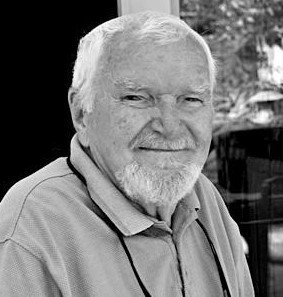 Thomas Stafford, son of Thomas Patrick Stafford and Margaret Doyle Stafford
Thomas Stafford, son of Thomas Patrick Stafford and Margaret Doyle Stafford“There would be music at the Stumble Inn. There was always music where the Irish gathered. I remember Jimmy (Richards) playing the fiddle. I spent quite a few days at Richards’ visiting with your dad ,Tib (Tobias Stafford). Clara (Richards Carberry) would feed us cookies. Jimmy thought we were a pain in the ass, I think. Peter (Stafford) was a great fisherman of mud pouts from the old Mississippi. In Ferguson Falls they were all related, either before or after they arrived in Canada from Wexford.”
(quote from Thomas ‘Tom’ Stafford 1921-2018)
(James ‘Jimmy’ Richards was Dad’s uncle on his Mother’s side. Clara Richards, Dad’s aunt, was Jimmy’s sister. Clara Richards married Thomas ‘Tom’ Carberry, a descendant of one of the ‘Seven Irish Bachelors’ of Ferguson Falls. The Richards homestead was next door to the Stafford homestead on the 11th concession of Drummond Township. Dad’s parents – Anastasia ‘Stacy’ Richards married Michael Vincent ‘Vince’ Stafford – the boy next door) Peter Stafford was Dad’s brother) ‘Wexford’ refers to County Wexford, Ireland. Jimmy Richards played his fiddle at the Stumble Inn on a regular basis. His fiddle was passed down to Dad, then to me.)
Billy McCaffrey, owner of The Stumble Inn
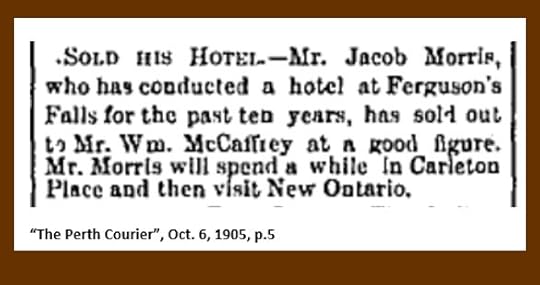
William Henry ‘Billy’ McCaffrey, (1869-1940), was the son of Joseph McCaffrey, and Ellen McGarry McCaffrey. Billy’s ancestor, Thomas McCaffrey was the first settler and resident of the village of Ferguson Falls, arriving in 1815.
Billy’s mother, Ellen McGarry McCaffrey:
 Ellen McGarry McCaffrey 1837-1917
Ellen McGarry McCaffrey 1837-1917Ellen McGarry McCaffrey and her husband, Joseph McCaffrey had ten children:
Mary McCaffrey 1861-1944 – was a tailorJulia Ann McCaffrey 1863-1944Thomas McCaffrey 1866-1913. Thomas married Margaret Doyle and they lived on the McCaffrey homestead on the 8th concession of Drummond Township. Thomas died age 46 of tuberculosisPeter McCaffrey 1867-1895 – died age 28 of dropsyWm. Billy McCaffrey 1868-1940 – saddler by trade, owned a hotel in Ferguson Falls, and later, owned the Stumble InnMargaret McCaffrey 1874-1917 died age 43 of pernicious anemiaLoretta McCaffrey 1872-1941 was a dressmakerGertrude McCaffrey 1875-1918 died age 38 of pernicious anemiaJosephine McCaffrey 1877-1931 trained as a nurse and worked in New York, died age 52 of cerebral hemorrhageTeresa McCaffrey 1879-1935, married Martin Sylvester Grace. Their children: Harold Francis Grace, Ursula Grace Kehoe Bent, Helen Grace Butterworth, Kathryn Grace Daley, and Reverend Sister Anna Gertrude.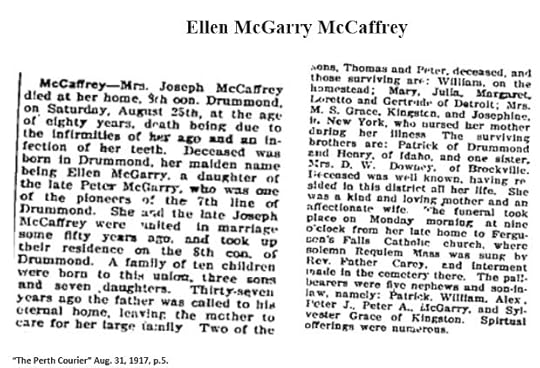 Ellen McGarry McCaffrey, daughter of Peter McGarry, niece of pioneers Elizabeth McGarry Stafford and Tobias Stafford
Ellen McGarry McCaffrey, daughter of Peter McGarry, niece of pioneers Elizabeth McGarry Stafford and Tobias StaffordAfter operating his successful and much-loved community gathering spot, the Stumble Inn, Billy passed away in 1940.
“The late Mr. McCaffrey was a man of sterling qualities, and possessed the good-will and esteem of all who knew him.”
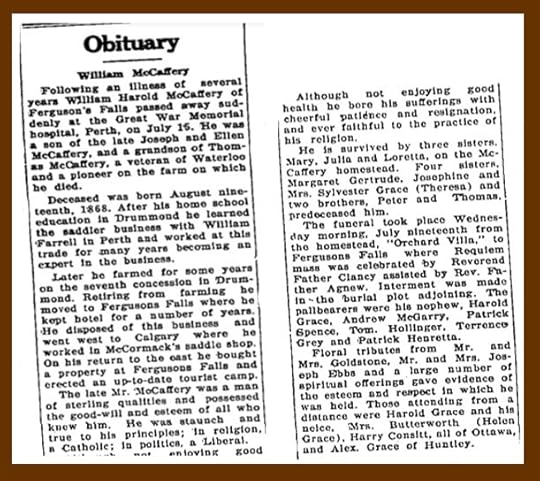 Billy McCaffrey’s obituary from “The Perth Courier” Aug. 2, 1940, p.3
Billy McCaffrey’s obituary from “The Perth Courier” Aug. 2, 1940, p.3 Billy’s and some of his siblings, St. Patrick’s cemetery, Ferguson Falls
Billy’s and some of his siblings, St. Patrick’s cemetery, Ferguson FallsFerguson Falls
(sometimes written as Ferguson’s Falls, or Fergusons Falls, depending on the era)
Originally known as Milford, Fergusons Falls was renamed in honor of the early settler Captain Ferguson when a post office was established there. This was the closest village to the Stafford farm and was a source for supplies, postal services, blacksmith services, social activities, and later St. Patrick’s Church.
Thomas McCaffrey was the first settler coming in 1815. McCaffrey was a close friend of Tobias Stafford and Betsy (McGarry) Stafford. Thomas was one of the witnesses to their marriage ceremony in St. John’s Church in Perth. He also signed his name as witness to one of Tobias’ later land transactions, and was present at the baptisms of some of the Stafford children.
Other early Ferguson Falls residents were John and Patrick Quinn, Patrick and Martin Doyle, James Carberry, James Power and William Scanlon. Two Stafford girls married into the Quinn family. The Hollinger family was also among the first settlers. By 1857, Ferguson Falls was booming. John Doyle was the Innkeeper, James McCaffrey was listed in the business directory as a Wagon Maker, and John & Michael McCaffrey were the local Blacksmiths. John Stafford, Tobias Stafford and Elizabeth McGarry’s son, was the area Shoemaker, and would later open a shoe store in Almonte, then in Perth. There was also a saw-mill, and a grist mill owned by Robert Blair and a hotel owned by Charles Hollinger.
Some history of Ferguson Falls:
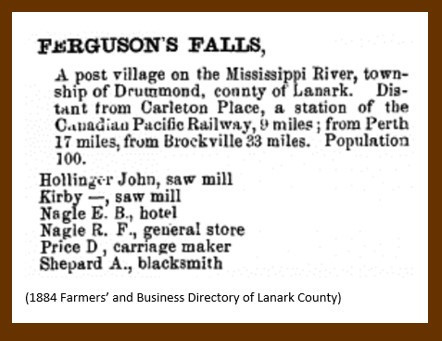 1884 Farmers’ and Business Directory
1884 Farmers’ and Business Directory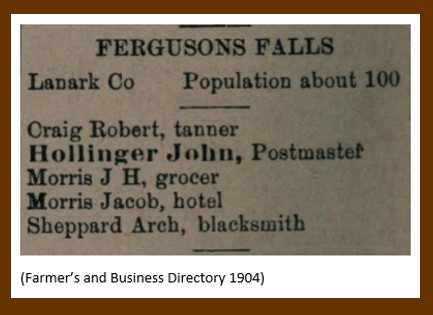 1904 Business Directory for Lanark County
1904 Business Directory for Lanark County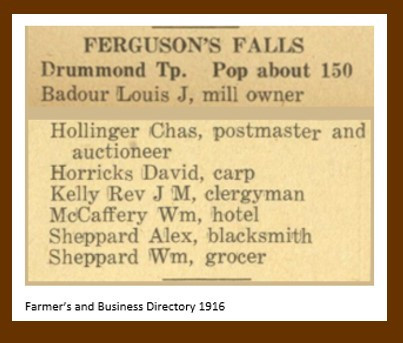 1916 Farmers’ and Business Directory for Lanark County
1916 Farmers’ and Business Directory for Lanark CountyA note on the local school:
“In 1894 Miss Mary Stafford taught, and then in 1901-1909 Miss Maggie Doyle of Drummond Twp (who later married Thomas Patrick Stafford).
In 1901 the teacher’s salary was $240.00 dollars a year. In 1905 it was $250.00. 1943-1946 Miss Mary Phelan of Lanark was the teacher. Her salary was $1000.00 a year and she had 9 pupils.”
(quote from Gail McFarlane, taken from the Tweedsmuir history of Ferguson Falls)
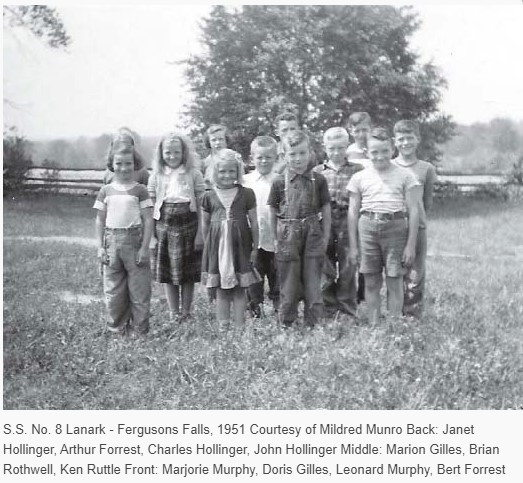
 S.S. # 15 Drummond Township School, class of 1928-29, with our cousins, Thomas ‘Tom’ Stafford (1921-2018) , Patricia ‘Pat’ Stafford, and Nora Stafford, (children of Thomas Patrick Stafford and Margaret ‘Maggie’ Doyle Stafford) Original photo at the Lanark Museum.
S.S. # 15 Drummond Township School, class of 1928-29, with our cousins, Thomas ‘Tom’ Stafford (1921-2018) , Patricia ‘Pat’ Stafford, and Nora Stafford, (children of Thomas Patrick Stafford and Margaret ‘Maggie’ Doyle Stafford) Original photo at the Lanark Museum.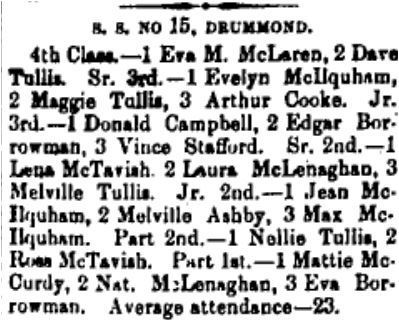
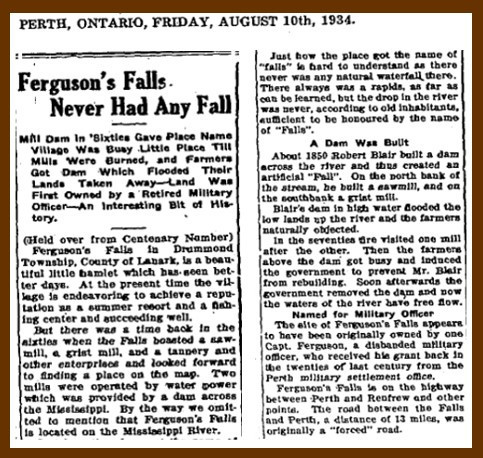 “The Perth Courier”, August 10, 1934 part 1 of 3
“The Perth Courier”, August 10, 1934 part 1 of 3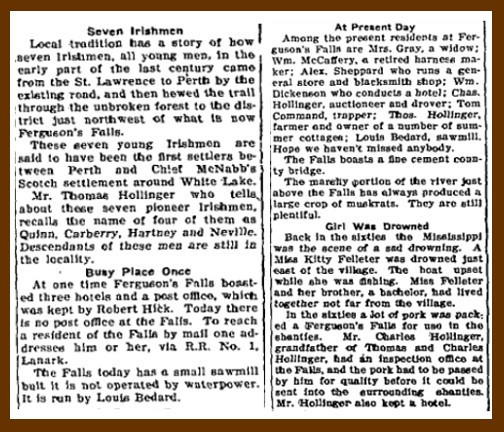 “The Perth Courier”, August 10, 1934 part 2 of 3
“The Perth Courier”, August 10, 1934 part 2 of 3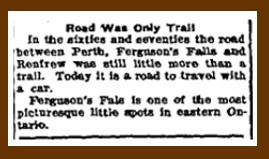 “The Perth Courier”, August 10, 1934 part 3 of 3
“The Perth Courier”, August 10, 1934 part 3 of 3 “The Perth Courier” Sept. 13, 1962, p.3
“The Perth Courier” Sept. 13, 1962, p.3 “The Perth Courier” Sept. 13, 1962, p.3
“The Perth Courier” Sept. 13, 1962, p.3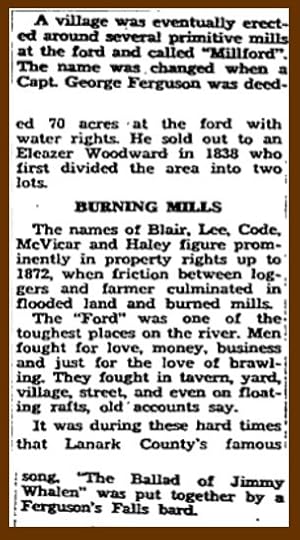 “The Perth Courier” Sept. 13, 1962
“The Perth Courier” Sept. 13, 1962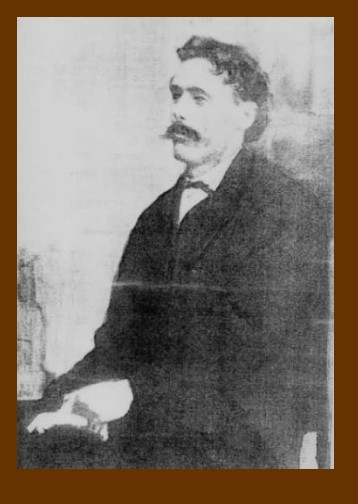 James ‘Jimmy’ Phelan (pronounced Whelan) Local lore says his lost love wanders in Ferguson Falls, along the Mississippi River at night, searching for Jimmy. The Phelan farm backed directly onto the Stafford homestead on the 11th concession of Drummond Township. Tim Doyle of Lanark village is said to have written the song.
James ‘Jimmy’ Phelan (pronounced Whelan) Local lore says his lost love wanders in Ferguson Falls, along the Mississippi River at night, searching for Jimmy. The Phelan farm backed directly onto the Stafford homestead on the 11th concession of Drummond Township. Tim Doyle of Lanark village is said to have written the song.Ballad of Jimmy Whelan
All alone as I strayed by the banks of the river
Watching the moonbeams as evening drew nigh
All alone as I rambled, I spied a fair damsel
Weeping and wailing with many a sigh.
Weeping for one who is now lying lowly
Mourning for one who no mortal can save
As the foaming dark water flow gently about him
Onward they speed over young Jimmy’s grave.
She cries, “Oh, my darling, please come to me quickly
And give me fond kisses that oft-times you gave
You promised to meet me this evening, my darling
So now, lovely Jimmy, arise from your grave.”
Slowly he rose from the dark, stormy waters
A vision of beauty more fair than the sun
Saying “I have returned from the regions of glory
To be in your dear loving arms once again.”
“Oh, Jimmy, why can’t you tarry here with me
Not leave me alone, so distracted in pain.”
“Since death is the dagger that’s cut us asunder
Wide is the gulf, love, between you and I.”
“One fond embrace, love, and then I must leave you
One loving farewell, and then we must part.”
Cold were the arms that encircled about her
Cold was the body she pressed to her heart.
Slowly he rose from the banks of the river
Up to the heavens he then seemed to go
Leaving this fair maiden, weeping and mourning
Alone on the banks of the river below.
(local Irish legends told of the ‘gates of glass’, where one could pass between this world and the next, through the water of a lake or river, at dusk)
 “The Perth Courier” continued from article above
“The Perth Courier” continued from article above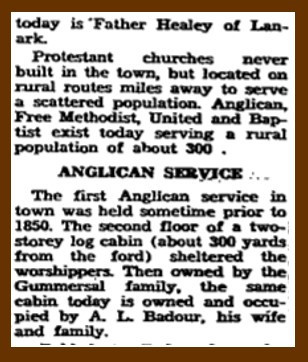 “Perth Courier” article – continued
“Perth Courier” article – continued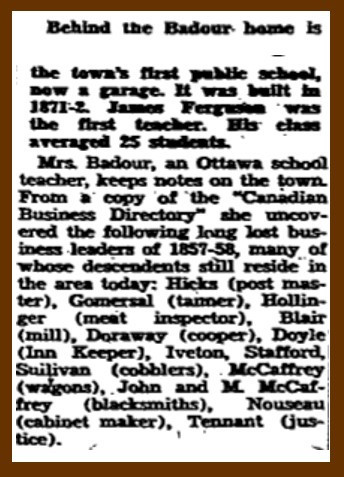 “Perth Courier” article continued
“Perth Courier” article continued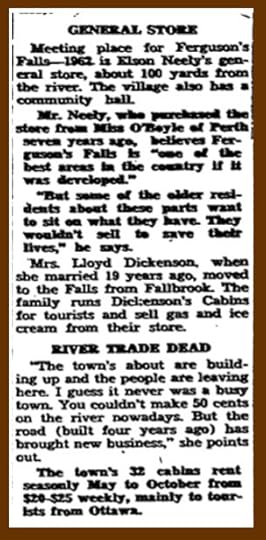 “The Perth Courier” – article continued
“The Perth Courier” – article continued “The Perth Courier” – article continued
“The Perth Courier” – article continued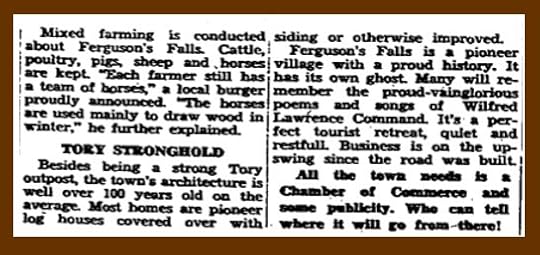 “The Perth Courier”, Sept. 13, 1962, p3, end of article
“The Perth Courier”, Sept. 13, 1962, p3, end of articleA Return to Our Roots in 2012
Archives Lanark celebrated their 10th Anniversary in October of 2012, at the Ferguson’s Falls Community Hall. There were local dignitaries from Drummond Township, and Doug Bell made a presentation of a 200 year old artifact, – an original settler’s trunk from pioneer Sutton Frizzell, and his land documents that were found in the trunk.
 Sutton Frizell’s trunks presented by Doug Bell to Archives Lanark
Sutton Frizell’s trunks presented by Doug Bell to Archives Lanark Sutton Frizell, one of the first elected Councillors in Drummond Township in 1850, along with Thomas McCaffrey, Murdock McDonald, Patrick Dowdall, and John Thompson
Sutton Frizell, one of the first elected Councillors in Drummond Township in 1850, along with Thomas McCaffrey, Murdock McDonald, Patrick Dowdall, and John ThompsonThere were also displays showing some highlights of the work that the Archives has done, and the variety of resources available for local researchers.
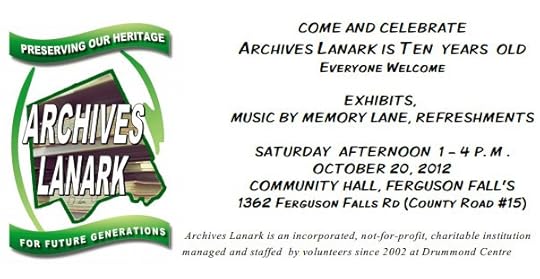
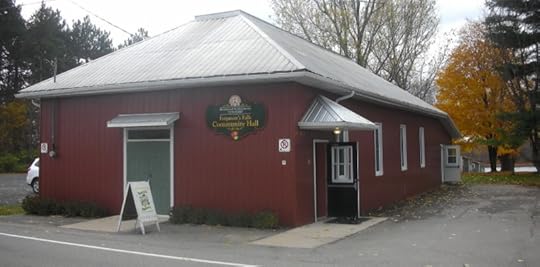 Ferguson Falls Community Hall, Oct. 12, 2012
Ferguson Falls Community Hall, Oct. 12, 2012 Archives Lanark 10th Anniversary – Arlene Stafford-Wilson at the book-signing table
Archives Lanark 10th Anniversary – Arlene Stafford-Wilson at the book-signing table Archives Lanark 10th anniversary 2012 – entertainment by ‘Memory Lane’, Mark Labelle on guitar on far left, Leo Scissions on guitar, with Heather Johnston on fiddle, and Jack Greer on banjo. (thanks to Stacey Horne, Arlene Quinn, and others who provided the names of the band members)
Archives Lanark 10th anniversary 2012 – entertainment by ‘Memory Lane’, Mark Labelle on guitar on far left, Leo Scissions on guitar, with Heather Johnston on fiddle, and Jack Greer on banjo. (thanks to Stacey Horne, Arlene Quinn, and others who provided the names of the band members)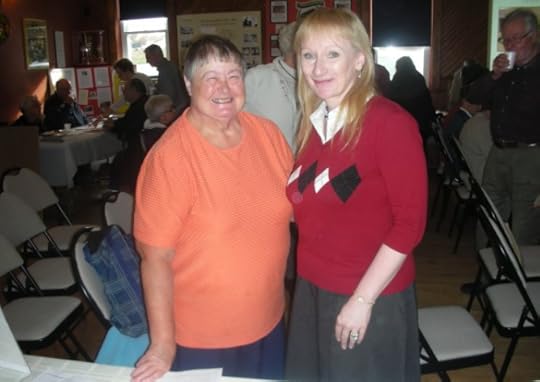 Archives Lanark 10th anniversary – with Elaine Morrow, from DeWitt’s Corners
Archives Lanark 10th anniversary – with Elaine Morrow, from DeWitt’s Corners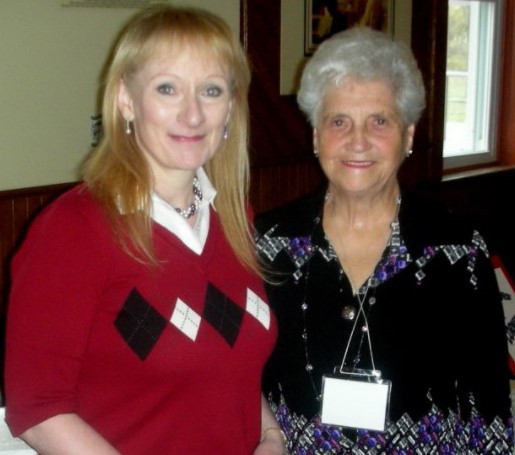 Archives Lanark 10th anniversary 2012, with Lanark County Genealogical Society members,
Archives Lanark 10th anniversary 2012, with Lanark County Genealogical Society members, Arlene Stafford-Wilson (left) and Irene Spence (rt)
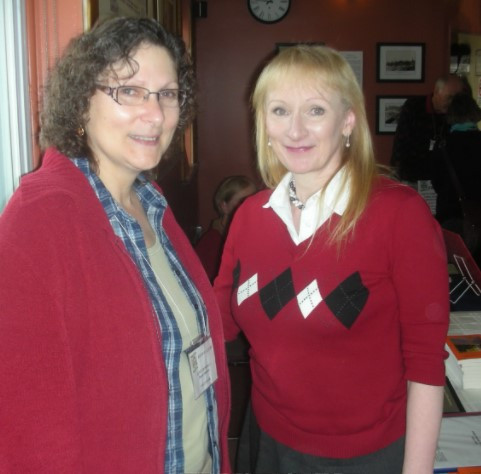 Archives Lanark 10th Anniversary in 2012, with Lanark County Genealogical Society President Janet Dowdall (left) , and LCGS member, Arlene Stafford-Wilson
Archives Lanark 10th Anniversary in 2012, with Lanark County Genealogical Society President Janet Dowdall (left) , and LCGS member, Arlene Stafford-Wilson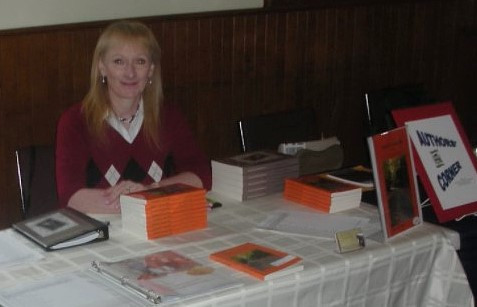 Arlene Stafford-Wilson at the Authors Corner, Ferguson Falls Community Hall, October 2012
Arlene Stafford-Wilson at the Authors Corner, Ferguson Falls Community Hall, October 2012Autumn in Ferguson Falls
 quote from “Lanark County Connections: Memories Among the Maples”
quote from “Lanark County Connections: Memories Among the Maples”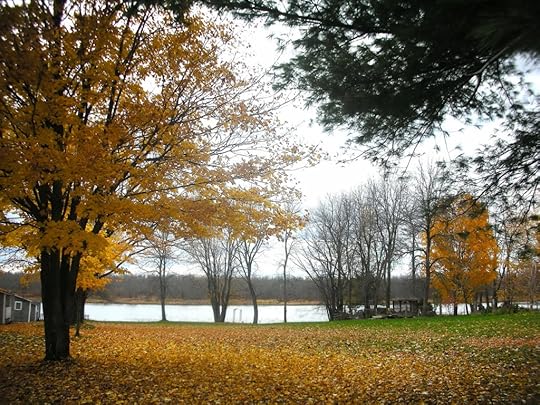 Picturesque Ferguson Falls, along the Mississippi River
Picturesque Ferguson Falls, along the Mississippi RiverStafford family Sunday drives in the 1960s and 1970s began on the Third Line of Bathurst, often involved detours though Balderson and Lanark village, but they always seemed to end up at Ferguson Falls. Our father was born and raised on the 11th concession of Drummond Township, on the ancestral Stafford farm, settled by pioneer, Tobias Stafford in 1816. Our ancestor spent his first year on what became known as Stafford Island on the Mississippi River before building a home.

In the earliest days of the settlement, priests would travel to these small communities, and Sunday mass would be held in someone’s home. Once St. John’s Church in Perth was built, the pioneers travelled by horse and buggy, or horse and cutter, to attend services, until 1856, when St. Patrick’s Church was established, along the river.
 St. Patrick’s Roman Catholic Church, and my brother, Roger Stafford, in Ferguson Falls
St. Patrick’s Roman Catholic Church, and my brother, Roger Stafford, in Ferguson Falls
…And so, we returned again and again to Ferguson Falls on our Sunday drives; to the pretty village in Drummond Township. We listened to our father’s accounts of the glory days of the Prestonvale ball team, and the long walks to school in snowstorms. We always stopped at St. Patrick’s church, and walked up and down through the rows of the graves of our ancestors. Dad’s parents were buried there, and his grandparents, and the oldest ones, who had come from Ireland. The old families were all connected by marriage – Quinn, McKittrick, Richards, Carberry, Carroll, Ryan, McCaffrey, and the rest; and he pointed to the headstones as we walked through the rows.
There were always stories of the infamous Stumble Inn, across the bridge from the church, and the card-games, and the drinking, and the fighting. We heard about Billy McCaffrey and how he sold whiskey at all hours of the day and night from his modest establishment. We learned of the Hollinger family and the generations of local auctioneers, and their busy hotel that catered to loggers. The loggers danced in their spiked boots and old Charlie Hollinger had to replace the floors once a year. We heard about the McEwen family and visited their popular maple shack in the spring. We heard the local names over and over: Blair, McFarlane, Horricks, Rathwell, Cullen and Kehoe.
We learned that the Irish Roman Catholics were a devoted bunch, loyal to their church, but also possessed an entirely different belief system that included ghosts and fairies, and the little people. We heard about Jimmy Whalen, a neighbour to the Stafford family, and how his lover could still be seen late at night walking along the banks of the Mississippi River, searching for her long lost Jimmy. We listened to stories about the lumber wars in the old days between the McLaren and Caldwell families, and the yearly cattle drives to Carleton Place.
The Sunday drive always ended the same way, with a visit to Lloyd and Evelyn Dickenson’s store for an ice cream cone and a bottle of Pure Spring pop. Dad and Lloyd talked about the old days, and walked together along the shore, near the cottages, recounting tales of catching bullfrogs, and fishing in the river.
I miss our drives to Ferguson Falls, and stopping for a bag of curd at the Balderson Cheese Factory along the way, visiting the graves of our ancestors, walking where they walked, and hearing the stories of the good old days. Dad, and his cousin Tom are gone now, but their stories live on. I often wonder if they told the same stories again and again so that we would remember; remember the place where the ancestors settled, remember the customs and legends from the old country, remember so that we could tell their stories, of this special place, called Ferguson Falls.
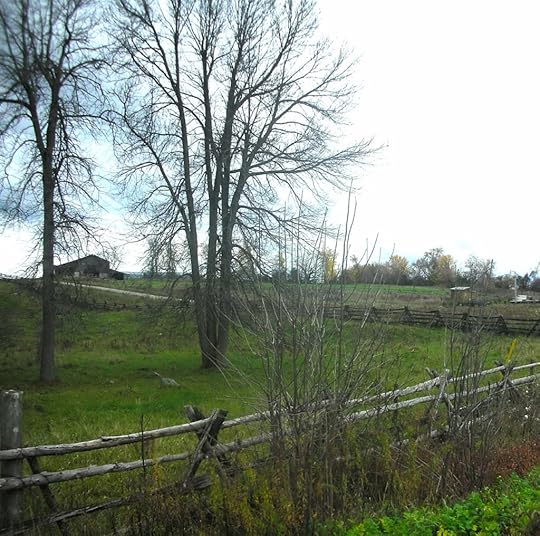
The old families of Ferguson Falls: Badour, Bennett, Blair, Byrne, Byrnes, Carberry, Closs, Craig, Cooke, Cullen, Cunningham, Cuthbertson, Dickenson, Donnelly, Doroway, Doyle, Ebbs, Ferguson, Finlayson, Forrest, Giles, Gommersall, Grey, Haley, Harrington, Hartney, Hicks, Hickey, Hogan, Hollinger, Horricks, Ireton, Keefe, Kehoe, Kenny, Little, McCaffrey, McEwen, McFarlane, McGarry, McIntyre, McIlquham, McLaughlin, McLenaghan, McNaughton, Montgomery, Moran, Moulton, Murphy, Murray, Nagel, Neville, O’Connor, O’Keefe, O’Sullivan, Phelan, Poole, Power, Price, Quinn, Rathwell, Robinson, Rothwell, Richards, Ruttle, Ryan, Scanlon, Spence, Stafford, Sullivan, Traill, Tullis.

For more information on Ferguson Falls and St. Patrick’s Roman Catholic Church: https://arlenestaffordwilson.wordpress.com/2012/07/06/st-patricks-church-fergusons-falls-lanark-county/
For Thomas Stafford’s account of the “Cattle Drives in Ferguson Falls” in “Lanark County Chronicle: Double Back to the Third Line”
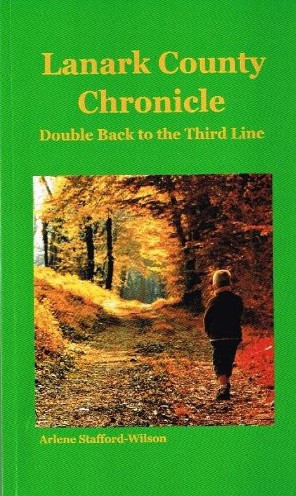
For the legend of Jimmy Whelan, – “The Ghost of Ferguson Falls” – “Lanark County Calling: All Roads Lead Home”
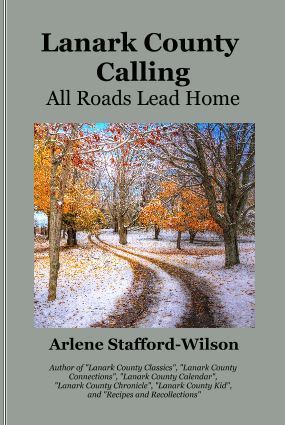
The story of “The Stumble Inn of Ferguson Falls”, from the book “Lanark County Collection”
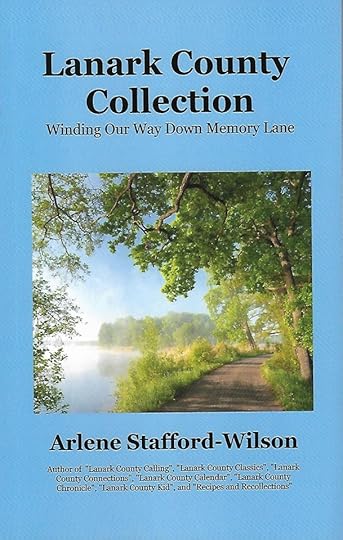
Books available at:
The Book Nook in Perth, Ontario
https://thebooknookperth.com/shop/
Spark Books in Perth, Ontario
Mill Street Books in Almonte, Ontario
 Arlene Stafford-Wilson
Arlene Stafford-WilsonFor more information about the author and the books:
July 13, 2022
Lanark Museum – Our Visit to the Past
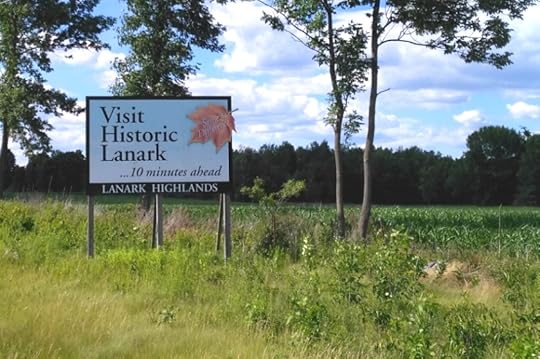
Just a short drive from the pretty town of Perth, along the Lanark Road, lush, green, farmers fields welcome us into the Township of Lanark Highlands. We follow the blue skies, and warm, summer winds, into the village of Lanark, and pull up near our destination – the Lanark and District Museum.

Greeted warmly by Anne Graham, we make our way up the well-worn steps, into a very special place, where the caretakers and guardians of our history, preserve our memories, our stories, and our heritage.
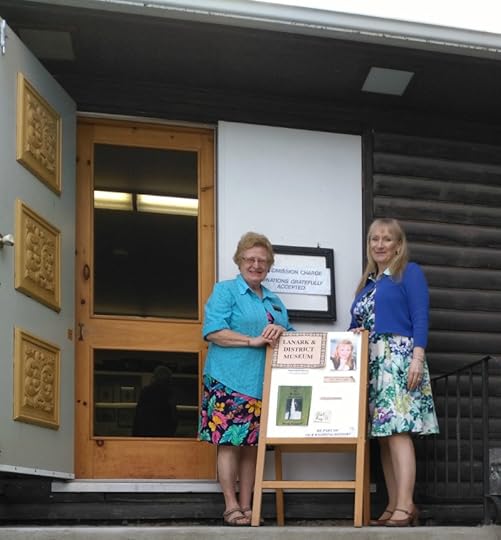
If you walk along George Street in Lanark, you will see a sign out front, greeting visitors, listing upcoming events, and welcoming all, with no charge for admission, and donations accepted. Anyone seeking knowledge, or in search of their history, is assured that they’ve come to the right place.
Not far from the front entrance, a plaque displays the names of those who went above and beyond, volunteering their time and expertise, throughout the decades, to keep the museum running smoothly.
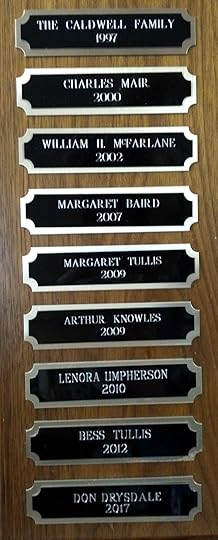
A photo on the wall reminds us of those who played key roles in the earliest days of the museum. Their foresight and dedication to preserving our local history leaves a lasting legacy, that will be enjoyed for many generations to come.
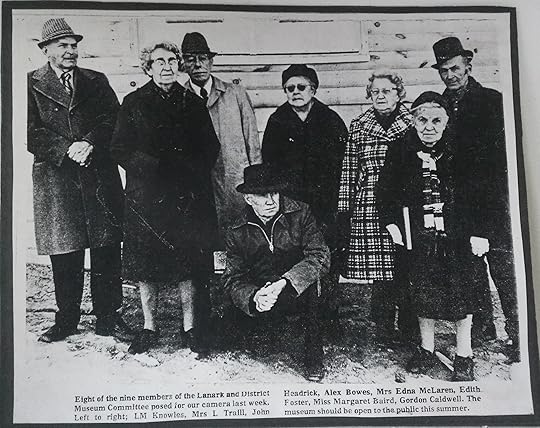
Many of us have ancestors from the area who served in the military, and the Lanark Museum has many displays highlighting our local heroes. Perhaps your ancestor is one of these soldiers who has been featured in the museum’s display cases.
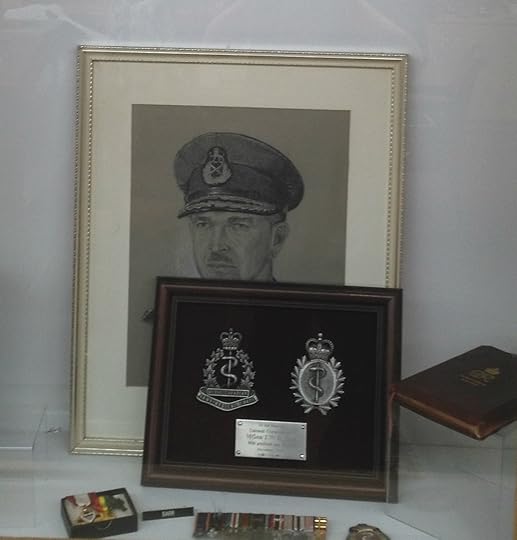
The museum also features a number of Rolls of Honour, listing the names of soldiers from the area who fought bravely for our country.
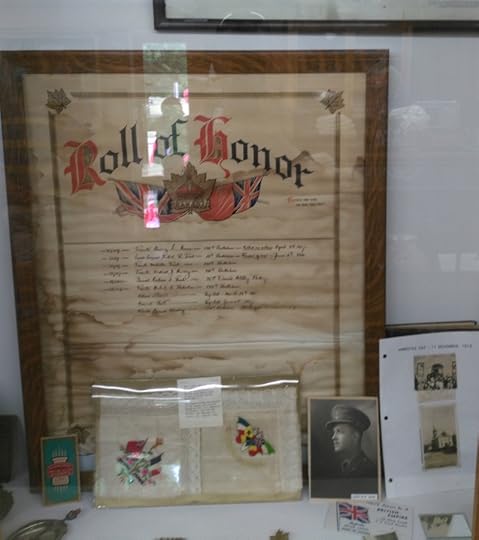
There are a tremendous number of local photographs. It’s great fun to see the old cars, some of the buildings no longer with us, and even recognize some of the smiling faces in these photos.
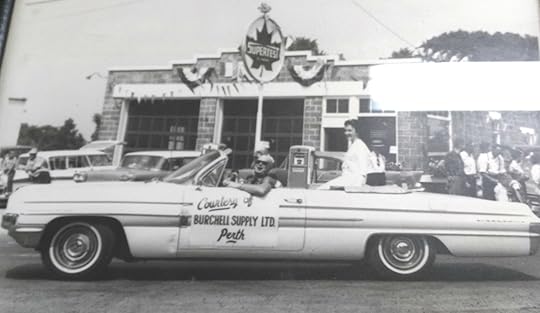
The museum is fortunate to have the help of two students for the summer. Meagan was kind enough to document our visit using her photography skills.
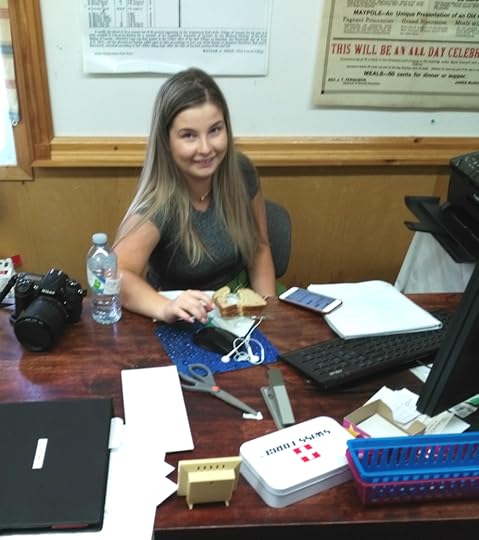
There is a wonderful display of original telegrams, some sent, and some received, by the Lavant Station, many years ago. These are real treasures, and give us some insight into the past and how different life was in those days! There are lots of familiar surnames on these telegrams, and some even provide a window into our family histories!
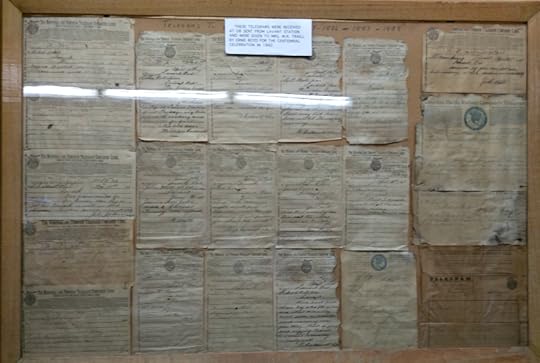
Along with the countless documents displayed there are also some lovely artifacts. The old wash bowl reminds us of the times before indoor plumbing was standard in our homes. We can imagine how different our ancestor’s lives might have been, and how carrying water from an outside well into the home was a daily event for these pioneers.
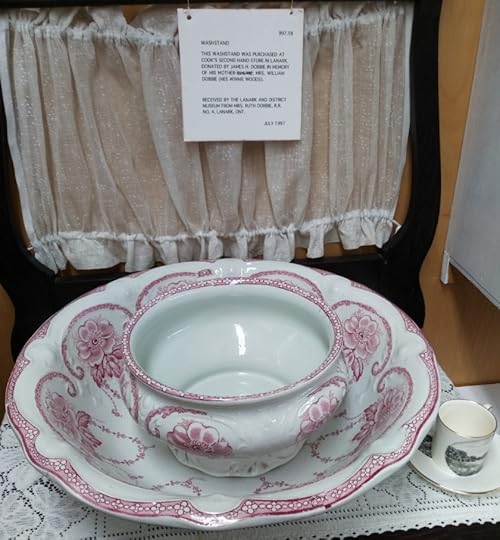
If your ancestors lived in McDonald’s Corners there is a wonderful remembrance displayed, honoring those who served their country, so well, and so faithfully.
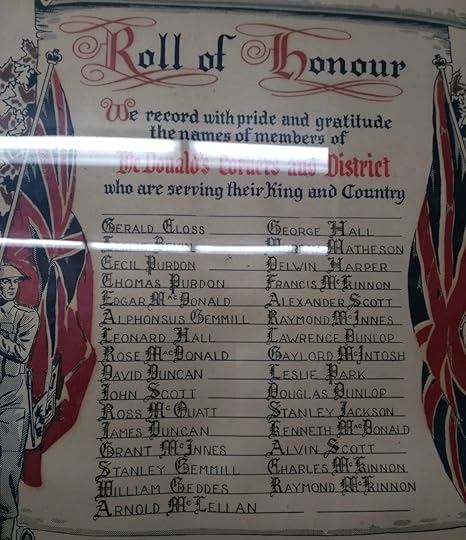
There are also a number of displays listing those soldiers who attended specific area schools and the names of those who served.
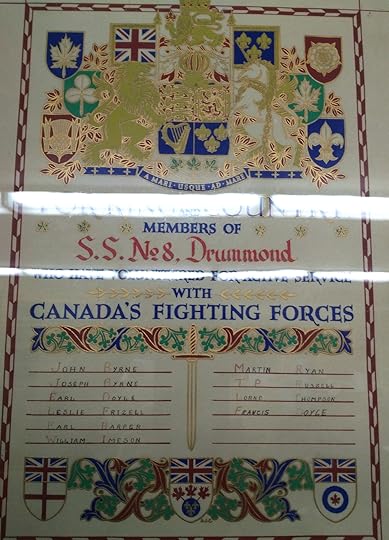
Another of the many area schools and their lists of those in service.
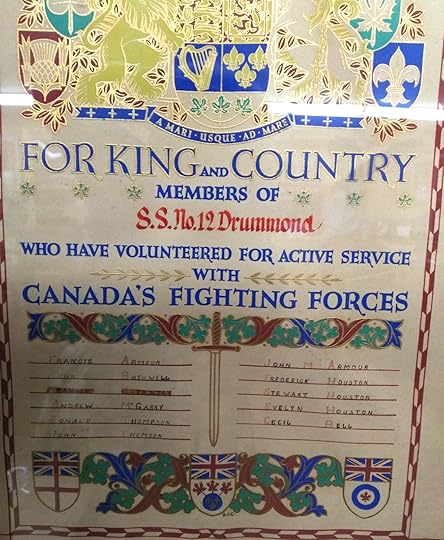
The Lanark Museum has many, many of these displays, and this is only a small sampling of what is available to view.
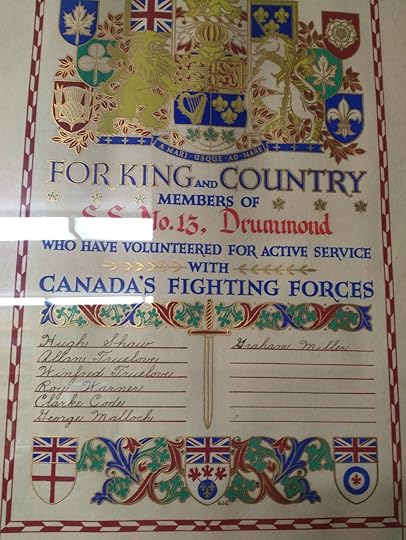
Being a history buff, it wasn’t easy to tear myself away from all of the exhibits in the museum, and get down to business, and read a couple of stories from my books. I chose two stories from “Lanark County Kid – My Travels Up and Down the Third Line”. I read one about a childhood visit to Lanark, and shopping for back-to-school clothing at the Kitten Mill.
My second story was “Balderson Cheese – Craving the Curd”. Our family often went on Sunday drives, and a visit to Balderson for a bag of soft squeaky curd, was something not to be missed! In the story, we go behind the counter, and watch the Master Cheesemaker, Omar Matte, and the others, while they stir the vats of heated milk, and then press the curds into big wooden circular presses. Considering that the factory is no longer there, it is a precious memory to have witnessed this process.
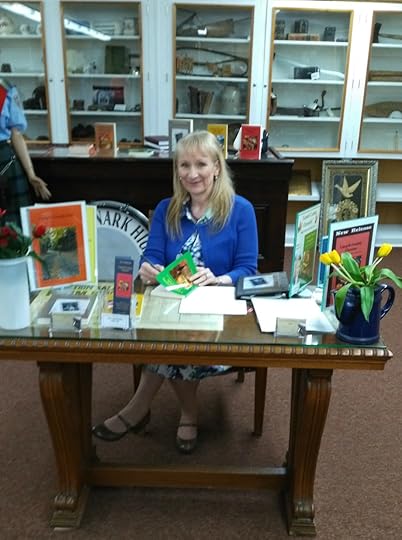
There are some really wonderful displays highlighting the Kitten Mill, and those who worked there over the years.
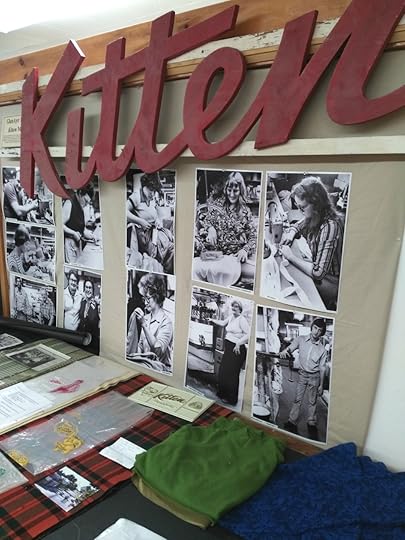
The Museum has done a wonderful job of preserving the artifacts and documents from the days of the Glenayr Kitten mills, and reminding us of the impact to employment and the economic influence to the village.
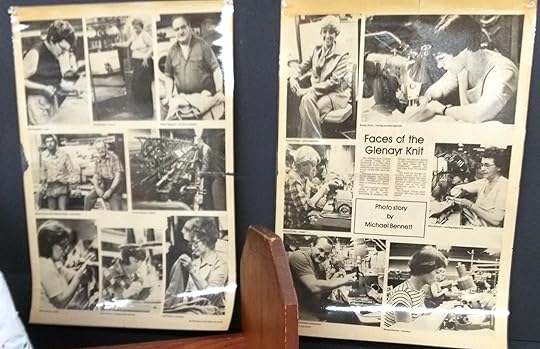
I think that many of us remember visiting the factory outlets, and all of the wonderful knitted clothing produced locally.
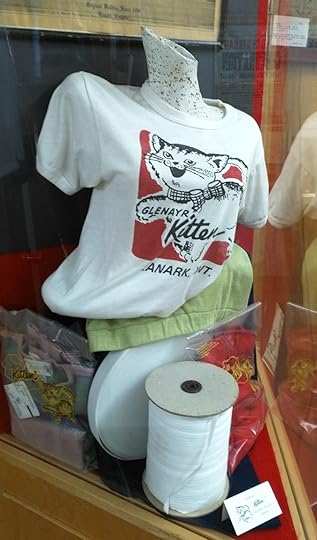
One of the special highlights for me was a visit with the Shamrock Quilt. While we can’t be sure of the date of its origin, I recall seeing it displayed at the museum many, many years ago, and was delighted to see it once again. This quilt is embroidered with the names of local families. If your family lived in the area it would be worth the trip to see this marvelous quilt, and discover your ancestor’s name embroidered in green.
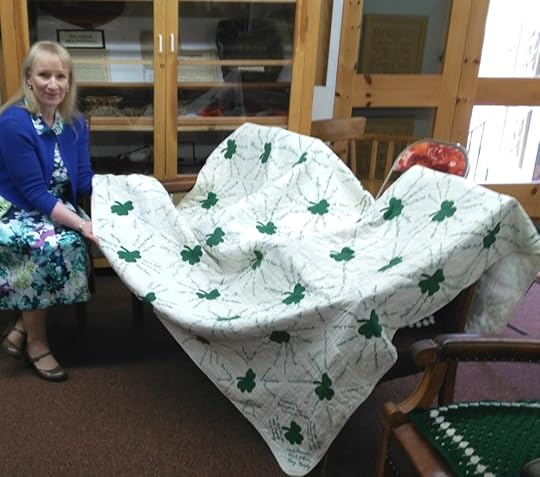
The Shamrock Quilt holds a special connection for Doris Quinn and myself. My Dad’s Aunt, Julia Stafford, married William Quinn, and both the Quinn and Stafford families are among the many, many, names on this precious artifact. It was a wonderful moment to be able to stand beside Doris, and see those names from the past, those who are no longer with us, but remain forever in our hearts.
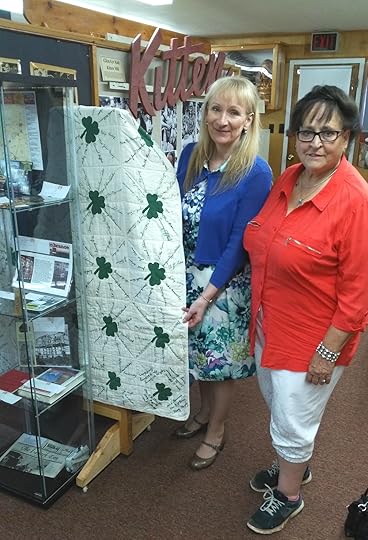
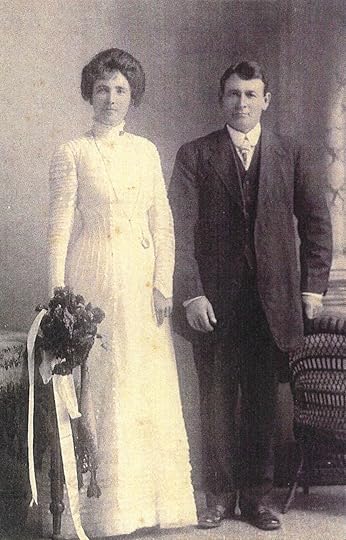
The following, are just a few squares, a small sample from the quilt, to show how the names have been stitched and displayed.
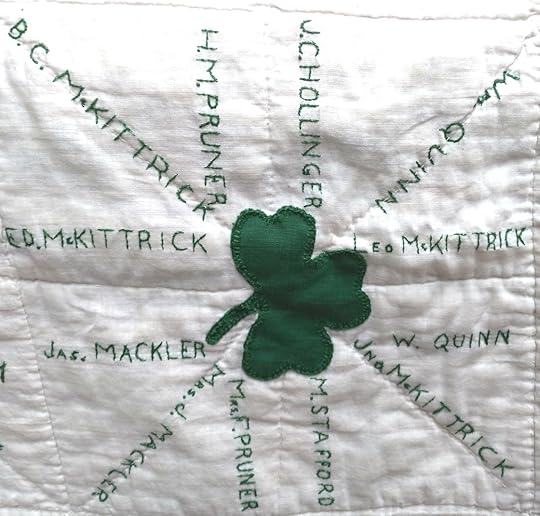
There are many other squares that were not photographed. Anyone with ancestors from this area may want to visit the quilt themselves for a more in depth look.
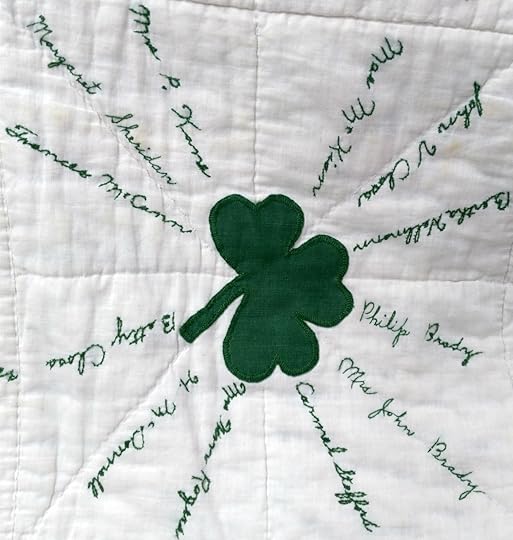
Another square of the quilt, but the quilt is enormous, and would be best viewed in person.
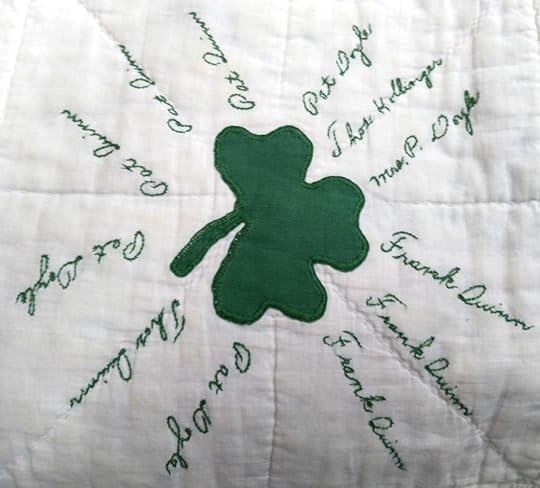
A final square from this historic piece. Hopefully the museum will photograph and digitize the entire quilt. That might be an interesting and very worthwhile project for the summer students!
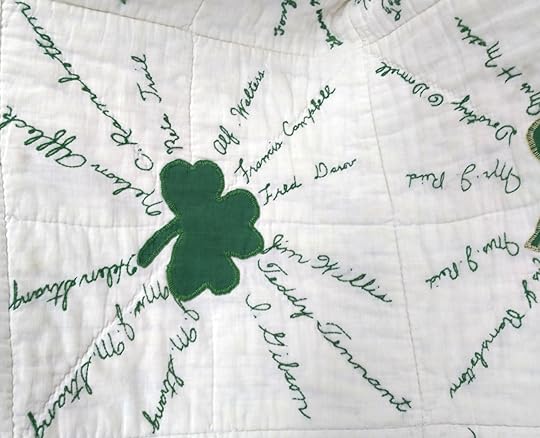
The late afternoon held a wonderful surprise – a visit from an old friend Susan Newberry Sarsfield. It was a real delight to visit with Susan, her Mom, and her daughter!
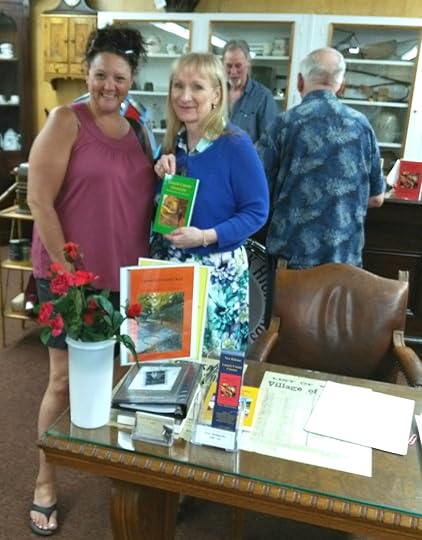
Like all good things, our visit to the Lanark Museum came to an end, and our host Anne Graham, kindly walked us out and into the sunny July afternoon.
It was a day filled with history, and the importance of preserving our past. There are few tasks more essential than being the caretakers of our heritage. The Lanark Museum is the proud custodian of our region’s artifacts, memories, stories, and treasures.
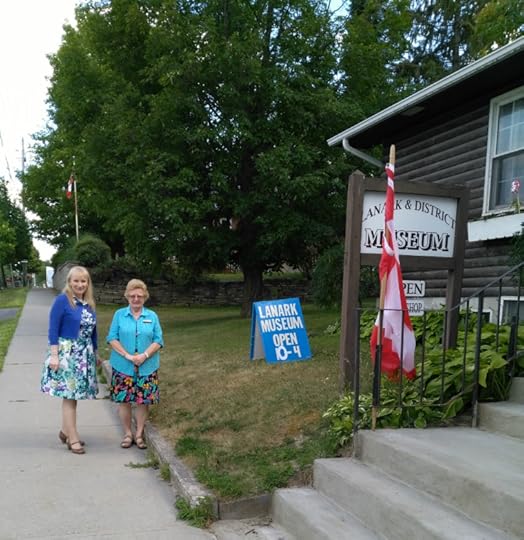
Many thanks to the kind folks at the Lanark and District Museum for hosting us, and sharing their collection of priceless treasures. Thanks also to the visitors who stopped by to share some stories and recollections. Anne, Norma, Gene, Doris – it was so nice to spend time with you – thanks for helping to make our day special.
As we said goodbye, and headed down the highway, we are struck by the pristine beauty of the Lanark Highlands, the clear waters, the fresh air, and the greenery as far as the eye can see, on this beautiful summer day.
Until we meet again…..

Available at: The Book Nook, Perth, Spark Books and Curios, Perth, Mill Street Books, Almonte
https://thebooknookperth.com/shop/
and
Arlene Stafford-Wilson
July 12, 2022
Lake Life – A Rideau Ferry Love Story
They were a couple of crazy kids from Kirkland Lake – outdoorsy-types, loved to ski and ride ski-doos, and most of all, they loved each other. After high school, they enrolled at Carleton U. , married in 1982, settled down in Orleans, and raised a couple of kids.
Twenty years ago they went for a drive, and that was the first time they laid eyes on the Rideau Lakes. They’d never seen anything so blue, so peaceful, and so perfect. He looked at her and said, “This place feels like home.” And at that precise moment, they decided that someday they would build a house on that very spot.
At first, they bought a trailer, and a plot of land near the shoreline, and every season, without fail, they returned to the Big Rideau.
Their kids grew up, and they knew that it was time – time to sell the house in the suburbs and build their dream along the water’s edge. The Big Rideau had been calling their names for years, and they were finally able to answer.
Mornings begin now with pink skies at sunrise, and waves gently lapping the shores. Evenings wind down to the sound of the loons as the sun dips low along the horizon and eventually disappears into the lake.

A bumper crop of apples, along with a perennial Perth Fair prize-winning recipe for Applesauce Loaf from “Recipes & Recollections”, filled their lake house with the warm scents of home baking.
Time is spent lovingly restoring a 1961 classic boat to her former glory, and day-trips to Perth or Brockville, along the scenic Rideau waterway.

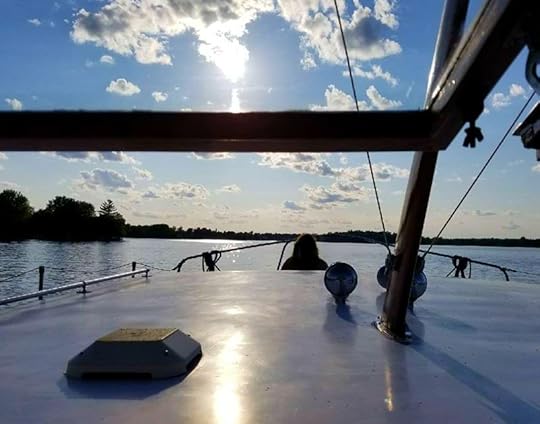
You never know who might stop by for a visit in Rideau Ferry!

Pull up a chair on the deck, and soak up the warm summer sun…

Make some new friends at the annual Rock the Dock…
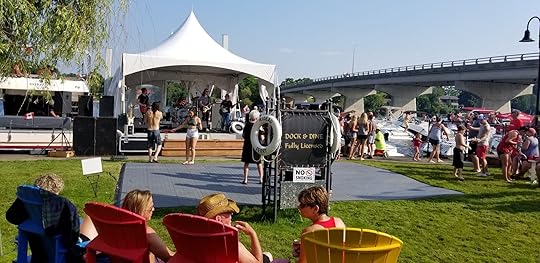
or dance the night away at the yearly corn roast, along the shores of the Big Rideau

Grab a cold drink, and sit outside at the fire pit.

Whether you feel like socializing, or would prefer a quiet evening listening to the sounds of the loons, there’s always something to do at the lake!

The beguiling charm of Rideau Ferry has been capturing the hearts of visitors and residents alike going back as far as the days of the pioneer settlers.
“One of the most notorious characters that passed his leisure time along the Rideau waterways was none other than Alphonse Gabriel “Al” Capone. Al Capone was a mobster based out of Chicago, and he made his fortune as a bootlegger, during prohibition.
He is said to have been a frequent visitor to a grand home in Kemptville, that was once owned by John Harris. Harris was a local who became a pharmacist, and worked in Chicago.
It has been suggested, that because of his background in chemistry and science, he was possibly cooking up quantities of moonshine in his home, and as you can imagine, this was of great interest to Capone.
In 1927 Harris built the beautiful, stone mansion that still stands today on Oxford Street in Kemptville. Locals say that the house was built with a state of the art security system, and series of underground passages. The grand home features leaded glass, a main switch to control all of the lights in the house, and a panic button wired directly to the local police station. It has yet to be confirmed that there are two tunnels leading from the house; one that links the home to the Kemptville Hotel, and the other which connects the house to the river.
Some of the stories have suggested that Capone himself hid a quarter of a million dollars, between the walls. Whether fact or fiction, witnesses, some of them lifelong residents of Kemptville, who were around in the 1930s and 40s, claim they saw many long, black limousines and the infamous black Cadillac parked at the home. Coincidentally or not, Harris sold the house, and moved away within a few weeks after Capone’s death.”
On a lighter note, one of the popular dance halls of the 1950s – 70s was known as the Rideau Ferry Inn. It was built on the site of what was originally a family home known as ‘Coutts House’.
After 1905, the building was rented to a series of business men. During the 1920s and 30s regattas became popular and Coutts House held canoe races and rowboats races. They also sponsored events for sailboats and it was the site of many grand daytime celebrations and intimate evening affairs for the wealthy travelers visiting in the summer.
In 1947 Doug Wallace, native of Osgoode, bought Coutts House, tore it down, and built a new structure, with wood framing and grey granite blocks. It was a two storey building and the second floor featured a large dance area with seating on three sides.
By the 1960s the building had become known as the Rideau Ferry Inn, and during this time became licensed for liquor sales. Up until that time people smuggled in their own booze, particularly in the roaring twenties when rum-running along the Rideau had its hey-day.”
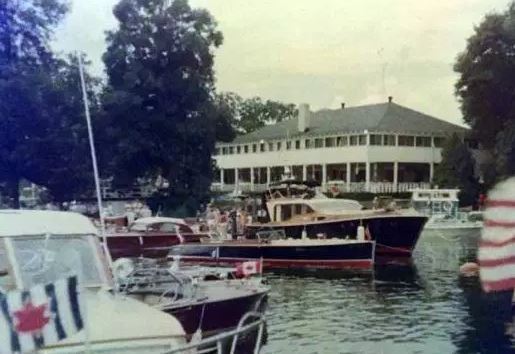
Whether you’re a visitor to the Rideau Lakes region, or living the ‘Lake Life’ like residents Ken and Carol-Ann McDougall, Rideau Ferry and its majestic, pristine waterways offers something for everyone.
With a rich history, and its striking beauty, the lakes are a wonderful place to pull up a chair and enjoy the view.
……………………………………………………………………………………………………………………………………………..
If you spend time around Rideau Ferry, you may hear these surnames that go back in the history of the area since the early days of the settlement:
Best
Bethune
Beveridge
Buchanan
Campbell
Cornell
Covell
Crombie
Dettrick
Donaldson
Fitzgerald
Frost
Gallagher
Gemmell
Gould
Grierson
Hall
Hitchcock
Houze
Irving
Jackson
Johnson
Joynt
King
Mathews
McCue
McKay
McLean
McVeety
Millar
Miller
Moore
Oliver
Poole
Purdon
Reid
Richards
Rintoul
Runge
Sewell
Shaw
Smith
Stewart
Taylor
Thomlinson
Tully
Vandusen
Wallace
Wills
Wilson
Wood
——-
Excerpts on Coutts House, Rideau Ferry, and Al Capone’s heyday, taken from:“Lanark County Chronicle – Double Back to the Third Line” ISBN 978-0-9877026-26
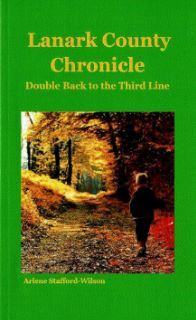
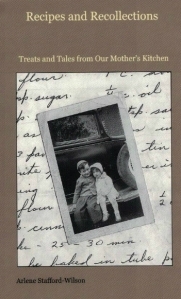 Available in local book stores, and online:
Available in local book stores, and online:https://thebooknookperth.com/product/lanark-county-chronicle-arlene-stafford-wilson/
Arlene Stafford-Wilson
www.staffordwilson.com
